- How to Order
Descriptive Essay
Descriptive Essay About A Place

Writing a Descriptive Essay About A Place - Guide With Examples
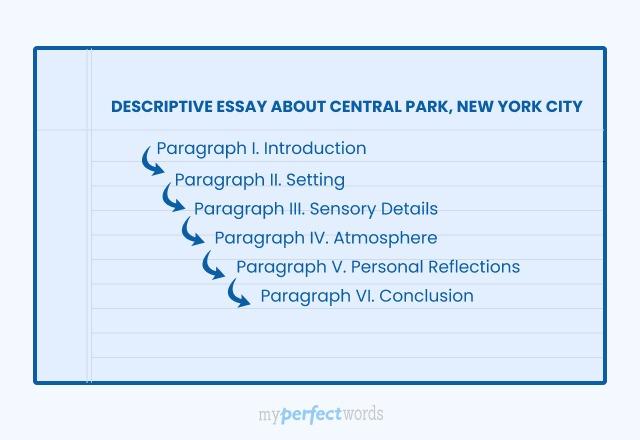
People also read
Descriptive Essay - A Complete Guide
Descriptive Essay Examples & Writing Tips
Top 250+ Descriptive Essay Topics & Ideas
Creating a Descriptive Essay Outline - Format & Example
Crafting an Authentic Portrait: A Guide to Writing a Descriptive Essay About a Person
Writing a Descriptive Essay About Myself - Tips and Tricks
How to Craft the Perfect Descriptive Essay About A Person You Admire
Descriptive Essay About My Mother - A Guide to Writing
Delicious Descriptions: A Guide to Writing a Descriptive Essay About Food
Write A Descriptive Essay About Nature With This Guide
Learn Tips to Write a Descriptive Essay About Autumn - Step into the Golden Season
Are you writing an essay about a place and need to know where to start?
The beauty of the world lies in its diversity, and every place has something unique to offer. A descriptive essay can bring these places alive for readers. But the question is, how do you write one?
Don't worry! We've got the right answer for you!
With a few examples and some tips on crafting your own essay, you can write it easily.
So read on to find good samples and tips to follow!
- 1. Understanding Descriptive Essays
- 2. Examples of Descriptive Essay About Any Place
- 3. Tips for Writing an Excellent Descriptive Essay About A Place
Understanding Descriptive Essays
A descriptive essay is a type of writing that aims to describe and portray an object, person, or place. The essay typically includes sensory details to help the reader imagine its contents more vividly. Descriptive essays can be written about a person , place, or other themes like nature , autumn , food , or even yourself .
A descriptive essay about a place should provide enough details for the reader to build a mental image of it. To do this, you need to include vivid descriptions and relevant information that could paint a picture in their minds.
Let's read some examples to see what a good descriptive essay looks like.
Examples of Descriptive Essay About Any Place
Here are some descriptive writing about a place examples:
Example of a Descriptive Essay About a Place
Descriptive Essay About a Place You Visited
Descriptive Essay About a Place Called Home
Descriptive Essay About a Place You Loved as a Child
Descriptive Essay About a Place of Interest I Visited
Descriptive Essay About a Favorite Place
Do you need more sample essays? Check out more descriptive essay examples t o get inspired.
Tips for Writing an Excellent Descriptive Essay About A Place
Now that you've read some examples of descriptive essays about places, it's time to learn how to write one yourself. Here are some tips on writing a great essay:
Choose The Right Topic
The topic of your essay should be something that you have a strong connection to or feeling about. It could be a place you've visited recently or a place from your childhood. Moreover, make sure that it's something that you can write about in enough detail to make your essay interesting.
Check out this blog with 100+ descriptive essay topics to get your creative juices flowing.
Gather Information
Gather as much information as possible about the topic of your essay. This will help you craft vivid descriptions and portray an accurate picture for your readers. Gather your observations, research online, and talk to people who have visited the place you're writing about.
Make sure to research the topic thoroughly so you can provide accurate and detailed descriptions. Read up as much as you can about the history of the place, and any interesting facts or stories about it.
Structure Your Essay
Outline your descriptive essay before beginning to write so all points flow logically from one to another throughout the entire piece.
Make sure to include a strong introduction and conclusion, as well as several body paragraphs that help support your main points.
Include Sensory Details
Use sensory language by including details such as sights, smells, tastes, sounds, etc. This helps to engage readers and transport them into the setting of your essay.
When writing a descriptive essay, make sure to include vivid descriptions that involve all five senses. This will help create a more engaging and immersive experience for your readers.
Use Vivid Language
Make sure to use strong and powerful words when describing the place you're writing about. Use metaphors and similes to bring your descriptions to life and make them more interesting for readers.
Proofread Your Essay
Proofreading is an important step in any writing process, especially when it comes to descriptive essays. Make sure to check for any typos or spelling errors that may have slipped through in your writing.
You also need to make sure that the flow of your essay is logical and coherent. Check if you've used a consistent point of view throughout, and make sure that all ideas are well-supported with evidence.
Follow these tips and examples, and you'll be well on your way to writing a great descriptive essay.
Don't stress if you still want a professional writer to do it for you. We've got the best solution for you.
MyPerfectWords.com offers excellent essay writing service for students to help them. Our experienced writers are here to provide high-quality and error-free work to help you get the grade you deserve. With our essay writing service, you are guaranteed a 100% original essay.
Get in touch with us to hire our descriptive essay writing service now.

Write Essay Within 60 Seconds!

Caleb S. has been providing writing services for over five years and has a Masters degree from Oxford University. He is an expert in his craft and takes great pride in helping students achieve their academic goals. Caleb is a dedicated professional who always puts his clients first.

Paper Due? Why Suffer? That’s our Job!
Keep reading
-10240.jpg&w=828&q=75)
Have a language expert improve your writing
Run a free plagiarism check in 10 minutes, generate accurate citations for free.
- Knowledge Base
- How to write a descriptive essay | Example & tips
How to Write a Descriptive Essay | Example & Tips
Published on July 30, 2020 by Jack Caulfield . Revised on August 14, 2023.
A descriptive essay gives a vivid, detailed description of something—generally a place or object, but possibly something more abstract like an emotion. This type of essay , like the narrative essay , is more creative than most academic writing .
Instantly correct all language mistakes in your text
Upload your document to correct all your mistakes in minutes

Table of contents
Descriptive essay topics, tips for writing descriptively, descriptive essay example, other interesting articles, frequently asked questions about descriptive essays.
When you are assigned a descriptive essay, you’ll normally be given a specific prompt or choice of prompts. They will often ask you to describe something from your own experience.
- Describe a place you love to spend time in.
- Describe an object that has sentimental value for you.
You might also be asked to describe something outside your own experience, in which case you’ll have to use your imagination.
- Describe the experience of a soldier in the trenches of World War I.
- Describe what it might be like to live on another planet.
Sometimes you’ll be asked to describe something more abstract, like an emotion.
If you’re not given a specific prompt, try to think of something you feel confident describing in detail. Think of objects and places you know well, that provoke specific feelings or sensations, and that you can describe in an interesting way.
Receive feedback on language, structure, and formatting
Professional editors proofread and edit your paper by focusing on:
- Academic style
- Vague sentences
- Style consistency
See an example

The key to writing an effective descriptive essay is to find ways of bringing your subject to life for the reader. You’re not limited to providing a literal description as you would be in more formal essay types.
Make use of figurative language, sensory details, and strong word choices to create a memorable description.
Use figurative language
Figurative language consists of devices like metaphor and simile that use words in non-literal ways to create a memorable effect. This is essential in a descriptive essay; it’s what gives your writing its creative edge and makes your description unique.
Take the following description of a park.
This tells us something about the place, but it’s a bit too literal and not likely to be memorable.
If we want to make the description more likely to stick in the reader’s mind, we can use some figurative language.
Here we have used a simile to compare the park to a face and the trees to facial hair. This is memorable because it’s not what the reader expects; it makes them look at the park from a different angle.
You don’t have to fill every sentence with figurative language, but using these devices in an original way at various points throughout your essay will keep the reader engaged and convey your unique perspective on your subject.
Use your senses
Another key aspect of descriptive writing is the use of sensory details. This means referring not only to what something looks like, but also to smell, sound, touch, and taste.
Obviously not all senses will apply to every subject, but it’s always a good idea to explore what’s interesting about your subject beyond just what it looks like.
Even when your subject is more abstract, you might find a way to incorporate the senses more metaphorically, as in this descriptive essay about fear.
Choose the right words
Writing descriptively involves choosing your words carefully. The use of effective adjectives is important, but so is your choice of adverbs , verbs , and even nouns.
It’s easy to end up using clichéd phrases—“cold as ice,” “free as a bird”—but try to reflect further and make more precise, original word choices. Clichés provide conventional ways of describing things, but they don’t tell the reader anything about your unique perspective on what you’re describing.
Try looking over your sentences to find places where a different word would convey your impression more precisely or vividly. Using a thesaurus can help you find alternative word choices.
- My cat runs across the garden quickly and jumps onto the fence to watch it from above.
- My cat crosses the garden nimbly and leaps onto the fence to survey it from above.
However, exercise care in your choices; don’t just look for the most impressive-looking synonym you can find for every word. Overuse of a thesaurus can result in ridiculous sentences like this one:
- My feline perambulates the allotment proficiently and capers atop the palisade to regard it from aloft.
An example of a short descriptive essay, written in response to the prompt “Describe a place you love to spend time in,” is shown below.
Hover over different parts of the text to see how a descriptive essay works.
On Sunday afternoons I like to spend my time in the garden behind my house. The garden is narrow but long, a corridor of green extending from the back of the house, and I sit on a lawn chair at the far end to read and relax. I am in my small peaceful paradise: the shade of the tree, the feel of the grass on my feet, the gentle activity of the fish in the pond beside me.
My cat crosses the garden nimbly and leaps onto the fence to survey it from above. From his perch he can watch over his little kingdom and keep an eye on the neighbours. He does this until the barking of next door’s dog scares him from his post and he bolts for the cat flap to govern from the safety of the kitchen.
With that, I am left alone with the fish, whose whole world is the pond by my feet. The fish explore the pond every day as if for the first time, prodding and inspecting every stone. I sometimes feel the same about sitting here in the garden; I know the place better than anyone, but whenever I return I still feel compelled to pay attention to all its details and novelties—a new bird perched in the tree, the growth of the grass, and the movement of the insects it shelters…
Sitting out in the garden, I feel serene. I feel at home. And yet I always feel there is more to discover. The bounds of my garden may be small, but there is a whole world contained within it, and it is one I will never get tired of inhabiting.
If you want to know more about AI tools , college essays , or fallacies make sure to check out some of our other articles with explanations and examples or go directly to our tools!
- Ad hominem fallacy
- Post hoc fallacy
- Appeal to authority fallacy
- False cause fallacy
- Sunk cost fallacy
College essays
- Choosing Essay Topic
- Write a College Essay
- Write a Diversity Essay
- College Essay Format & Structure
- Comparing and Contrasting in an Essay
(AI) Tools
- Grammar Checker
- Paraphrasing Tool
- Text Summarizer
- AI Detector
- Plagiarism Checker
- Citation Generator
Prevent plagiarism. Run a free check.
The key difference is that a narrative essay is designed to tell a complete story, while a descriptive essay is meant to convey an intense description of a particular place, object, or concept.
Narrative and descriptive essays both allow you to write more personally and creatively than other kinds of essays , and similar writing skills can apply to both.
If you’re not given a specific prompt for your descriptive essay , think about places and objects you know well, that you can think of interesting ways to describe, or that have strong personal significance for you.
The best kind of object for a descriptive essay is one specific enough that you can describe its particular features in detail—don’t choose something too vague or general.
Cite this Scribbr article
If you want to cite this source, you can copy and paste the citation or click the “Cite this Scribbr article” button to automatically add the citation to our free Citation Generator.
Caulfield, J. (2023, August 14). How to Write a Descriptive Essay | Example & Tips. Scribbr. Retrieved August 30, 2024, from https://www.scribbr.com/academic-essay/descriptive-essay/
Is this article helpful?

Jack Caulfield
Other students also liked, how to write a narrative essay | example & tips, how to write a literary analysis essay | a step-by-step guide, how to write an expository essay, get unlimited documents corrected.
✔ Free APA citation check included ✔ Unlimited document corrections ✔ Specialized in correcting academic texts

How to Write a Descriptive Essay about a Place

If you’re not sure what exactly a descriptive essay is and how to write one, you’ve come to the right place. I’m Tutor Phil, and in this tutorial I’ll explain how a descriptive essay works and how to write it, step by step.
We’ll write one together, so you’ll have a great example of a descriptive essay.
What Is a Descriptive Essay?
A descriptive essay is a piece of writing in which the author describes a place, a person, an object, an animal, or a process. The purpose of a descriptive essay is to move the reader to some kind of a revelation, conclusion, or decision about the subject.
It is very important to note that a descriptive essay is not an argumentative essay. You’re not presenting an argument and doing whatever it takes to support it.
In a descriptive essay, your intention should be to describe the subject in such a way that the reader would create her own impression of it.
At the same time, your essay is not neutral because it is colored by your own perception or experience of the subject.
In other words, you are implying and suggesting, not blatantly pushing an opinion.
You want to let the reader see, hear, touch, smell, and taste the place you’re describing. And that experience should lead the reader to an appropriate impression or conclusion.
Writing a Descriptive Essay Is a 6-Step Process
Step 1. choose the subject.
Maybe your instructor has already chosen the subject for you. If not, choose a country, city, or a place within a city or a geographical location that you are familiar with.
Ideally, it is a place that you have been to and have a good memory of it. A descriptive essay about a place should not rely solely on research, in most cases.
The real value of your essay is that you know that place, and perhaps it has a special meaning for you or evokes feelings that no other place can evoke.
So, unless you have to write about a specific place where you have never been, choose a location that has a special place in your heart.
Sometimes, your subject can be a place with which you may have negative associations. But most likely, it is a beloved place that has left an indelible impression on your heart and mind.
Criteria for choosing the place
- Ideally, this place should be dear to your heart
- It is unique. It is unlike any other place you’ve ever been to, in at least one or two important ways
- It has left a strong impression on you
- Perhaps you learned something there
- Perhaps something wonderful happened to you there, such as meeting your soulmate or discovering something about yourself
- Ideally, it has special visual qualities that stand out in contrast to what your audience is probably used to. In other words, being visually striking is a huge plus.
I’ll give you an example. For me, one particular little spa town in Europe won me over when I first visited it many years ago. Its name is Carlsbad, or Karlovy Vary. The terms are interchangeable. One is of German origin, and the other is native Czech.
It is located in the western part of Czech Republic, not too far from the German border. It is serene, spectacular, and magical, and I’ll choose it as the subject for our sample descriptive essay.
By the way, Carlsbad, California was named after Karlovy Vary because of the similar mineral content of the underground waters found in the American cousin city.
Step 2. Pick an audience
I understand that you’re probably writing this essay to fulfill a requirement for your class. In which case, your audience is your teacher or professor.
But even if you’re writing for your instructor, you should still have a particular audience in mind because this will help you form ideas and keep your thoughts flowing.
Knowing your audience will inform your choices of what to include and what to exclude in your descriptive essay because your reader may care about some aspects of this place but not others.
Criteria for choosing an audience
- Your ideal reader is someone who is most likely to be interested in this place
- It is someone who is likely to enjoy reading your essay
- Your ideal audience is also someone who will benefit from reading about this place and derive the most value from it
Let’s come back to our example of Karlovy Vary. As I already mentioned, it is a spa town, which means that its attractiveness lies in its therapeutic qualities.
I first visited this gem of a town back in 2004 as a result of a real academic and professional burnout. I believe I was still an undergraduate student finishing up my studies, and I also had a stressful job.
I lived in Brooklyn, which is a borough of New York City, and this metropolis is known for its stressful lifestyle.
New York has all the disadvantages of living in a large city, such as pollution and other stressors that can really suck the life energy out of its dwellers if they are not careful.
I lived in New York for 25 years, and I love this city. I don’t want to come across as totally negative about it.
But focusing on the negatives about my city in this case will help you see how I am choosing the audience for this essay we’ll be writing together in this tutorial.
You see, New York City is a direct opposite of Karlovy Vary in several critical ways.
Establishing a contrast helps define an audience
New York is noisy. Drivers here are notorious for incessant horn honking. And you can hear an ambulance or a police siren probably every 15 minutes or so.
Conversely, Karlovy Vary is super quiet. Such a crazy hustle and bustle doesn’t exist here, and drivers don’t have a reason to honk the horn all the time. It is also very rare to hear a police or an ambulance siren.
Air quality in New York is decent for a big city, but it is still relatively polluted . All the millions of cars and trucks produce way too much carbon dioxide. You can actually see the smog from some vantage points.
The air in Karlovy Vary is virtually pristine. The town is surrounded by hills, and car traffic is not allowed in the city center.
The landscape in New York is a bit monotonous and often fails to inspire. They don’t call this city “a concrete jungle” for nothing. The overall atmosphere is hardly conducive to a great mood or daily inspiration.
Conversely, Karlovy Vary offers aesthetically pleasing, relaxing, and inspiring architecture and landscape. It’s like entering a spa, only the spa is a whole town.
Now that we have this contrast, it is easy to see who might be interested in learning more about Karlovy Vary. Our ideal audience is someone who:
- Lives in a big metropolis, such as NYC or another big city
- Can relate to being excessively stressed out
- Is aware of noise and air pollution
- Would love an escape to relax and renew, even if only by reading an essay.
So, our essay becomes a sort of a virtual or a fantasy escape until an actual trip becomes possible.
Your audience might have different challenges, needs, and desires. It could be someone who:
- Is nostalgic about their childhood and a place associated with it
- Dreams about a perfect place to live and work
- Plans a retirement location
Think of these factors when determining your audience. In the meantime, because we’ve already identified our ideal reader – a stressed out urban dweller – we can move on to the next step.
Step 3. Divide the subject into subtopics
No matter what kind of an essay you’re writing, you want to divide the main topic into subtopics. In other words, you want to create some kind of a structure that will consist of parts.
I use and teach my students to use the technique I call the Power of Three.

What this means is that instead of having just one big topic, such as one town, we can have three aspects of this town to discuss.
Incidentally, we already talked about three major differences between NYC and Karlovy Vary. These are noise levels, air quality, and landscape. So, perhaps we can use one or more of these aspects of a city as sections of our essay.
We must keep in mind that we’re not writing a comparative essay , although that’s a possibility, too.
We’re writing a descriptive essay. So, we need to find three aspects of the town that we can discuss one after another to put together a rich and detailed enough picture of this place.
Note that these three aspects correspond to the senses of hearing, smell, and sight.
Let’s make a preliminary list of such aspects of Karlovy Vary:
- Quietness. Does this aspect present an interesting description opportunity? This will depend on our ability to turn it into an asset.
- Air quality. This may be too specific. We may want to zoom out a little and discuss more than one natural asset of this city. Some of the others include water quality and the industries associated with it.
- Landscape. This is the most conspicuous aspect of this city. The first thing you’re struck with is how beautiful this place really is. This one is definitely a winner.
If we go about writing about these three aspects of Karlovy Vary creatively, we will have three nice sections or paragraphs that will form the body of our essay.
Note that we’ll probably use more than one sensory perception, such as sight or smell, in each section. We’ll simply use one of three senses as a primary focus in each of our three sections.
It would make sense to begin the discussion of the city by describing it visually. So, this will be our primary focus in the first section.
Then, we can proceed to the sense of hearing. Why? Because our last section will be about air and water. And we should probably leave those for last because we can hear the water before we can taste it. That’s just the way it works in Karlovy Vary.
So, the primary sense perception in our second section will be hearing. And this section won’t be just about how quiet it is.
In fact, the real contrast between a big city and Karlovy Vary is the quality of the soundscape, not just the simple quietness, although it’s a part of it. So, we’ll focus on all the little sounds that make this place unique.
Finally, in the third section or paragraph, we’ll talk about the air and the water, which will correspond to the senses of smell and taste, primarily.
Again, we’ll be using any sense perceptions we feel necessary to make the reader’s experience as real as possible.
And now we have our place, we know our audience, and we have our three main ideas about this place that we’ll use to structure the essay.
We can begin writing, and we’ll start with the opening paragraph.
Step 4. Write the introduction
An introductory paragraph in a descriptive essay offers you a lot of flexibility in how you choose to write it.
You can start off with a particular example of a sense perception, drop your reader in the middle of a town square, or begin with an abstract concept.
I would like to suggest an easy and practical way to do it. In the first sentence or two, pull your reader from the outside world into this particular magical place you’ve chosen to write about.
Then, focus on the place you want to describe and say something general about it that would set the context or provide a perspective.
And finally, set some kind of an expectation for what’s to follow. You can create a sense of mystery, if you like. Remember, this is not an argumentative essay. So, you have more room for creativity.
This is where we begin to put together our descriptive essay example. Let’s write our introductory paragraph.
Descriptive Essay Introduction
“When the city has worn you down, the body is tired, and the soul yearns for a respite, you can count on a little magic gem of a town that will nourish you back to life. The name of the place is Karlovy Vary, and it is nested in the heart of Europe, in Western Bohemia, a region in Czech Republic famous for its spa towns. Its beautiful architecture, therapeutic landscape, clean air, and mineral waters offer the weary a healing adventure and a feast for the senses.”
What have we done in this paragraph?
We’ve pulled the reader into the world of this small spa town. We first descended in their world of the stressful city, and then we turned their attention to its opposite. We named the town and explained where it is located.
And finally, we provided a glimpse of what to expect in this descriptive essay about this town. Now, we’re ready to write the body of the essay.
Step 5. Write the body of the essay
We know our three main sections, which in this case correspond to three sense perceptions. Each section can have more than one paragraph. It all depends on how long your essay has to be.
If you are writing an essay of about 500-600 words, then a five-paragraph structure will do the job. If you need to write 2000 words or more, then you’ll have three sections instead of just three paragraphs.
And then each section can also be divided into two or three subsections (using the Power of Three, if you like). And each subsection can be a paragraph or more.
Just remember – the more words you need, the more dividing into subtopics you must do. The key to writing more is dividing one idea into several supporting ideas. And then you simply treat each supporting idea as a tiny essay.
If you struggle with essay writing in general or need to brush it up, I recommend you read my tutorial on essay writing for beginners . This would be a great place to turn to next.
Now, let’s write out our body paragraphs. Since there’s quite a bit to cover, we’ll probably take two paragraphs per section to get the job done.
Descriptive essay body paragraphs
“When you stay in one of the pretty little hotels in Karlovy Vary, you are likely to be descending the hills towards the hot springs every morning. No matter which part of town you live in, you’ll be greeted with a magnificent sight of little hotels and spas whose architecture has a unifying 19th century style. At the same time, each building has its own character, color, and features. The town is situated on several hills, and the hotels are lined up along about four levels.
The first level is down by the river Tepla, and these hotels are only a few because most of the downtown is occupied with hot springs colonnades where people gather and drink hot mineral water. The next three levels ascend from the springs, and you can either take the stairs or even use a funicular that will take you to the highest level to the Hotel Imperial. As you exit your hotel in the morning, you are greeted with a sight of a collection of small, three to four story buildings that look like birthday cakes. They are pink, green, blue, red, turquoise, and any color you can imagine. You suddenly realize how this variety of colors and shapes strewn over the hillsides all facing you and the city center makes your head spin and makes you feel like you’ve never felt before. Your healing has begun with landscape therapy.
As you descend the stairs to reach the hot springs, you notice the abundance of oxygen in the air because it has a subtle but distinct smell, a bit like the way air smells right before a rain. Then, as you pass by another hotel, and you’ll pass more than one, a light whiff of toast and fried eggs with bacon hits you, stirring your appetite. It is customary to drink a cup of hot mineral water before you come back to your hotel for breakfast. It is called a drinking cure.
As you keep walking towards the geyser and the springs that surround it, you notice another astonishing detail. Nobody is in a rush. Nobody has anywhere to be except right here, right now. Travelers with cute little porcelain cups stroll along without a worry in the world, taking in the sights, the smells, and the sounds of the birds chirping and singing all around. Their serenity infects you. You slow down, too. You begin to look, smell, and listen. This town has got you.
Karlovy Vary is famous for its healing mineral waters that are known to alleviate gastrointestinal issues. These waters really do have magic powers. You have your little sipping cup with you, and when you reach one of the springs, you wait for your turn to fill it up, walk off, and begin sipping. The water has a very subtle smell, but its taste is pretty strong for water. It has very high mineral content and tastes salty. Most people like the taste. Some find it too strong. But one thing is for sure – by the time you’re about half way through with your cup’s content, your digestive juices have begun to stir.
The hot springs flow out through several fountains, each with its own intricately detailed colonnade. The mineral content of water bursting out of each fountain is identical. But the temperature of the water varies from really hot to mild and comfortable. Your “spa doctor” actually prescribes which fountains to use and how much to drink. Sipping the water out of a special porcelain cup with a built-in straw-like system is a special pleasure of its own. The point is not to rush but to take about 20 minutes to empty the cup. In the meantime, you have a chance to take in the magnificent serenity that surrounds and infuses you. When you’ve drunk your water, it is time to head back to your hotel and eat breakfast. You repeat this routine three times a day for the duration of your stay. By day three, you are serenity itself. By day fourteen, you are a brand new person.”
Step 6. Write the conclusion
A conclusion in a descriptive essay is, like the introduction, more flexible than a conclusion in an argumentative essay.
You can conclude your essay in any way you really want as long as you observe one rule. Just make sure you zoom out and write in more general terms.
It is not the time to add specific details and examples. This is the time to wrap things up and end on a general note.
Your conclusion can be very short – only a couple of sentences. But you can take your space and write as much or as little as you feel like. You can always go back and trim it down or beef it up.
Let’s write our conclusion.
Our Conclusion
“Upon reading this, you may feel that this town is described as some sort of a paradise. And in a way, it is, especially if you are traveling from a big city and carrying a load of accumulated stress. But it’s not until you see, touch, smell, hear, and taste it for yourself that this European jewel will become a part of your entire being forever.”
It’s okay to be a little emotional and perhaps to even exaggerate a little in the concluding paragraph. Just notice that this one is more general than any of the body paragraphs.
It also touches upon or mentions every sense perception evoked in the body of the essay.
Your Key Takeaways
- A descriptive essay is much more flexible and has a lot fewer rules than an argumentative essay.
- Use the five sense perceptions – sight, smell, touch, taste, and hearing – to structure your essay.
- You don’t have to organize your essay by sense perceptions. You can divide your place into sections and walk the reader through each one.
- You can even structure your essay as a string of paragraphs that describe one particular walk or route, from beginning to end.
- Our last body paragraph is a description of the process of drinking hot mineral water in Karlovy Vary. It is a perfect example of a description of a process, if you ever want to write that kind of an essay.
- Don’t persuade but subtly suggest.
- Show, don’t tell, whenever you can.
A Few Scenic Snapshots of Karlovy Vary’s Charm

I hope this was helpful. Now go ahead and write that descriptive essay about a place!
Tutor Phil is an e-learning professional who helps adult learners finish their degrees by teaching them academic writing skills.
Recent Posts
How to Write an Essay about Why You Want to Become a Nurse
If you're eager to write an essay about why you want to become a nurse, then you've arrived at the right tutorial! An essay about why you want to enter the nursing profession can help to...
How to Write an Essay about Why You Deserve a Job
If you're preparing for a job application or interview, knowing how to express why you deserve a role is essential. This tutorial will guide you in crafting an effective essay to convey this...
Jun 27, 2023
Descriptive Essay Examples: Bring Your Writing to Life with Vivid Descriptions and Engaging Language
Dive into the vibrant world of descriptive writing! Discover how to captivate your audience with rich details and stirring language, creating immersive experiences with your words!
Immerse yourself in the vibrant art of descriptive writing in this comprehensive guide. Throughout this article, we'll explore the intricacies of crafting descriptive essays, offering you useful tips, and showcasing compelling examples.
You'll learn the essence of sensory details in creating vivid imagery, the structure of a captivating essay, and pointers for picking engaging topics. Our journey will feature rich examples like a description of the Grand Canyon, demystifying the language techniques used.
So, are you ready to amplify your writing skills and charm your readers with words? Dive right into the world of descriptive essays and let your creativity flow!
Understanding Descriptive Essays
Before we delve into crafting engaging descriptive essays, let's clarify their fundamental purpose. Each essay type serves a unique role, and for descriptive essays, the objective is to paint an elaborate picture using vivid language and sensory details. As a writer, your goal is to transport readers to a particular location, event, or time, allowing them to experience it through their senses.
Among different essay types, each comes with a specific objective. Let's consider a few:
Narrative Essays: These essays recount a story or event. Your goal here is to craft a captivating narrative that keeps your reader engrossed from beginning to end.
Descriptive Essays: The focus of a descriptive essay is to create a vivid mental image for your reader. By using intricate details and expressive language, you invite readers into a sensory experience, making them feel as if they're part of the story.
Expository Essays: In an expository essay, the aim is to clarify or inform. You should present information in a clear, concise manner, educating your reader about a particular topic or issue.
Persuasive Essays: Persuasive essays aim to convince the reader to adopt a certain viewpoint or perform a specific action. Your task here is to utilize evidence and logical reasoning to support your argument, persuading your reader to agree with your stance.
In the context of creative writing, which includes forms like short stories, poetry, novels, and memoirs, descriptive writing serves as an essential tool. Through the use of metaphors, vivid descriptions, and other literary devices, writers can create a powerful impact and engage readers in an imaginative experience.
Whether you are aiming for fiction or non-fiction, creative writing offers a platform to explore your creativity, express your thoughts, ideas, and experiences in an original and unique way. It invites experimentation with styles, genres, and techniques, allowing for the creation of unique literary pieces.
Improving creative writing skills is an ongoing journey, with numerous resources available, including online courses and writing workshops. So, embark on your creative journey, explore your imagination, and unlock your creative potential!
In conclusion, understanding an essay's objective is a crucial step towards successful writing. A clear definition of the essay's purpose guides you to develop a robust thesis statement and structure your arguments effectively, making your essay a compelling read.
The Framework of a Descriptive Essay
Descriptive essays breathe life into words by painting a vivid picture of a person, place, thing, or experience. They employ sensory details and expressive language to make the subject come alive for the reader. Here's a basic yet effective structure you might use when crafting a descriptive essay:
1. Introduction
Your introduction should pique the reader's interest and provide some context for your essay's subject. Begin with an engaging statement about your subject, an intriguing rhetorical question, or an interesting fact to hook your audience. Subsequently, introduce your thesis statement, a clear declaration of the particular aspect or impression of the subject you will be describing.
2. Body Paragraphs
The body of your essay should dive into a detailed description of your subject. Each paragraph should spotlight a unique facet of your subject, using sensory details to paint a vibrant image for the reader. Language techniques such as metaphors, similes, and personification can enhance your descriptions. Depending on your subject and its characteristics, you may want to organize your paragraphs in chronological or spatial order.
3. Conclusion
The conclusion should encapsulate the key points of your essay, leaving a lasting impression on your reader. Restate your thesis statement and offer a brief summary of your main points. Conclude with a striking statement or image that underscores your essay's primary theme.
Bear in mind that this structural blueprint for a descriptive essay is flexible and may require adjustments based on the specific topic or purpose of your essay. Still, this basic outline provides a robust foundation to organize your thoughts and guide your journey in crafting a compelling descriptive essay.
Expanding Your Imagination: Descriptive Essay Writing Inspiration Ideas
Crafting a remarkable descriptive essay involves bringing a scene to life with your words. This immersive style of writing can be applied to a variety of topics. Here are some areas you might want to explore:
1. Recalling Cherished Memories
Our minds are vaults of experiences just waiting to be unraveled. Dive into your childhood memories and bring forth a moment that left an indelible mark on you. Remember to describe the environment, your emotions, people around you, and why this memory has remained so vivid over the years.
2. Exploring Unfamiliar Territories
Have you always dreamt about a certain place but never had the chance to visit? This is your opportunity to transport your readers to this location using your imagination. Research, craft an image, and explore this place in your mind, then share it with your audience.
3. The Magic of the Seasons
Every season carries its unique charm. Pick your favorite season and describe its essence. Use sensory details to communicate the change in the atmosphere, the transformation in the landscape, and how these alterations make you feel.
4. Delving into Personal Relationships
Consider a person who has made a significant impact on your life. It could be a family member, a friend, or even a celebrity. Describe them and explain why they are so influential. Discuss their characteristics, their words, actions, or ideas that have inspired you.
5. Relishing in the Gastronomic Delights
Food can elicit powerful memories and emotions. Describe your favorite dish or a memorable meal in great detail. Use descriptive language to convey its flavors, textures, and aromas, and share why it holds a special place in your heart.
6. Reimagining Historical Events
Historical events offer rich ground for descriptive essays. Choose an event that interests you and imagine you're a part of it. Describe the environment, the people, their emotions, and the atmosphere during this event.
Remember, the key to writing a compelling descriptive essay is to paint a vibrant picture using your words. By carefully selecting your subject and using detailed, sensory language, you can create a narrative that captivates your readers and provides them an experience to remember. Be creative, have fun with your writing, and let your imagination roam free.
Descriptive Essay Examples
Example essay 1: "my favorite place" .
My favorite place in the world is my grandparents' farm in the countryside. As I walk down the dirt road that leads to the farmhouse, I am greeted by the sweet smell of hay and the sound of crickets chirping in the distance. The rolling hills that surround the farm are covered in lush green grass and dotted with wildflowers of every color. The old wooden barn and weathered farmhouse are a testament to the many years of hard work and love that my grandparents have put into this land. I can't help but feel a sense of peace and belonging when I am here, surrounded by the beauty of nature and the memories of my family.
Example Essay 2: "The Haunted House"
As I stepped through the creaky gate and onto the overgrown path that led to the abandoned mansion, I felt a chill run down my spine. The house's ivy-covered walls and broken windows loomed over me like a giant beast waiting to pounce. The air was thick with the scent of decay and mold, and the sound of rustling leaves and distant whispers made me feel as if I was not alone. As I explored the dark and eerie interior of the house, I couldn't help but feel as if I was stepping into a nightmare. The peeling wallpaper and rotting floorboards added to the sense of dread, and the only light came from the occasional flash of lightning that illuminated the shadows. I left the haunted house feeling as if I had been transported to another world, a world of darkness and fear.
Example Essay 3: "A Day at the Beach"
The sun was blazing down on the white sand and turquoise waters of the beach as I settled onto my towel and let the warm breeze wash over me. The sound of crashing waves and seagulls filled the air, and the salty smell of the ocean mingled with the sweet scent of coconut oil and sunscreen. The water was crystal clear, and I could see schools of brightly colored fish darting in and out of the waves. As the day wore on, I built sandcastles with my nieces and nephews, went for a swim in the cool water, and soaked up the sun until my skin was golden brown. As the sun began to set and the sky turned fiery orange and pink, I knew that this was a day I would never forget.
Example Essay 4: "The City at Night"
The city comes alive at night, its streets bathed in the glow of neon lights and the hum of activity. The air is filled with the scent of roasted peanuts and hot dogs, and the sound of honking horns and chatter of people fills your ears. The towering skyscrapers loom above you, casting long shadows that stretch across the sidewalks. The city never sleeps, and you feel alive in its energy and vibrancy.
Example Essay 5: "My First Love"
The moment I laid eyes on her, I knew I was in love. Her eyes were like pools of emerald green, and her smile was like sunshine on a cloudy day. Her voice was soft and musical, and I could listen to her talk for hours. We spent every moment we could together, exploring the city, watching movies, and talking about everything and nothing at all. Even now, years later, I can still feel the warmth of her hand in mine and the thrill of our first kiss.
Example Essay 6: "A Winter Wonderland"
As I stepped outside into the winter wonderland, I was struck by the beauty of the snow-covered landscape. The trees were draped in a blanket of white, and the snow sparkled like diamonds in the sunlight. The air was cold and crisp, and my breath formed puffs of steam as I exhaled. I bundled up in my warmest coat and gloves and set out to explore the snowy wonderland, feeling like a child again.
Example Essay 7: "The Perfect Day"
The perfect day for me is one where the sun is shining, the birds are singing, and the world is filled with endless possibilities. I wake up early and savor a cup of hot coffee as I watch the sunrise from my front porch. Then, I spend the day exploring the great outdoors, hiking in the mountains, swimming in a crystal-clear lake, and soaking up the beauty of nature. In the evening, I enjoy a delicious meal with my loved ones, and we laugh and share stories until the stars come out.
Example Essay 8: "A Magical Place"
As I stepped through the door of the tiny bookstore, I felt as if I had been transported to a magical world. The shelves were lined with books of every size and color, and the air was thick with the scent of old paper and ink. The cozy armchairs and crackling fireplace invited me to curl up with a good book and get lost in a story. I spent hours exploring the aisles and discovering hidden treasures, feeling as if I had found a secret portal to another world.
Example Essay 9: "The Taste of Home"
The taste of my grandmother's cooking is something that will always hold a special place in my heart. Her homemade apple pie was the perfect combination of sweet and tangy, with a buttery crust that melted in my mouth. Her hearty beef stew warmed my soul on cold winter nights, and her homemade bread was the perfect accompaniment to any meal. Every bite was infused with love and care, and I can still taste the flavors of my childhood in every dish she made.
Example Essay 10: "The Seashore"
As I walked along the sandy shore, the sound of crashing waves filled my ears and the salty ocean air tickled my nose. The sun beat down on my skin, warming me from the inside out. I closed my eyes and listened to the seagulls calling overhead and the laughter of children playing in the distance. The water lapped at my toes, sending chills up my spine. It was the perfect day at the beach, and I never wanted it to end.
Example Essay 11: "The Concert"
The roar of the crowd and the pulsing beat of the music filled the arena, making my heart race with excitement. The lights flashed in time with the music, casting the performers in a rainbow of colors. The lead singer's voice soared through the air, and I felt as if I were transported to another world. The energy was electric, and I couldn't help but dance along with the crowd, lost in the music.
Example Essay 12: "Autumn Leaves"
The trees were ablaze with color, their leaves a riot of red, orange, and gold. The air was crisp and cool, and the sound of rustling leaves echoed through the quiet streets. The smell of wood smoke and pumpkin spice filled the air, and I felt a sense of peace and contentment wash over me. As I walked through the park, I kicked up piles of leaves and marveled at the beauty of the season.
Example Essay 13: "The Old House"
The old house was a thing of beauty, its weathered exterior and ivy-covered walls telling the story of years gone by. As I stepped inside, the creaking floorboards and musty smell of old books greeted me, transporting me back in time. The rooms were filled with antique furniture and intricate wallpaper, and the sunlight streaming through the dusty windows cast a warm glow over everything. I felt as if I were a character in a novel, exploring the secrets of this forgotten place.
Example Essay 14: "The First Snowfall"
As I looked out the window, I saw the first snowflakes of the season drifting down from the sky. The world outside was transformed, the trees and buildings dusted with a layer of pristine white. The air was cold and crisp, and the sound of snow crunching underfoot was a satisfying crunch. I couldn't help but smile as I stepped outside, feeling the snowflakes land on my cheeks and melt against my skin.
Example Essay 15: "The Mountain"
As I hiked up the mountain, the air grew cooler and the scenery became more breathtaking with every step. The rugged landscape was dotted with trees and boulders, and the sound of rushing water filled the air. I paused to catch my breath and took in the panoramic view of the valley below, feeling small and insignificant in the face of such natural beauty. It was a humbling experience, and I felt grateful for the opportunity to witness it.
Example Essay 16: "The Market"
The market was a cacophony of sights, sounds, and smells. The vendors called out their wares in a dozen different languages, and the smell of spices and fresh produce mingled in the air. I wandered through the crowded stalls, admiring the handmade crafts and sampling the local delicacies. It was a feast for the senses, and I couldn't help but be swept up in the energy of it all.
Example Essay 17: "The Sunrise"
As the sun rose over the horizon, the sky was painted with hues of pink, orange, and gold. The world was quiet, and the only sound was the gentle lapping of the waves on the shore. I watched in awe as the sun slowly crept higher into the sky, casting its warm glow over everything in its path. It was a peaceful moment, and I felt a sense of renewal and hope for the day ahead.
Remember, when writing a descriptive essay, it's important to use sensory details to create a vivid picture in the reader's mind. These examples demonstrate how descriptive language can help to bring a place, experience, feeling, or season to life. Use these examples as inspiration for your writing and experiment with different techniques to find your unique style.
In conclusion, the art of crafting a compelling descriptive essay lies in harnessing sensory details and vivid language to immerse readers in your narrative. Constant practice and experimentation with various literary techniques will help refine your unique style.
To further boost your writing skills, consider leveraging the power of AI tools like Jenni.ai . This advanced writing assistant provides features such as AI Autocomplete, In-text Citations, and Paraphrase & Rewrite, effectively enhancing your writing process. With global acclaim, Jenni.ai accelerates your writing speed and caters to a broad spectrum of writing needs.
In essence, combining your creativity with potent AI assistance can elevate your writing quality, efficiency, and overall experience, ultimately taking your descriptive essay skills to the next level.
Start Writing With Jenni Today
Sign up for a free Jenni AI account today. Unlock your research potential and experience the difference for yourself. Your journey to academic excellence starts here.
Descriptive Essay: Your Guide to Writing an Effective One

A descriptive essay is one of the four main types of essays, alongside narrative, argumentative, and expository essays. Among these, descriptive essays can be particularly challenging because they demand a keen eye for detail and an appreciation for aesthetics. By vividly describing scenes and details, you engage your reader’s senses, making your essay memorable and engaging. In this guide, our essay writers will break down the writing process for you, offering step-by-step instructions, practical examples, and clear definitions to help you excel in your next assignment.
What is a Descriptive Essay?
Descriptive writing aims to vividly portray something through essays, helping readers visualize and feel the scene or object being described. Such essays draw on detailed descriptions to create a clear and impactful image that not only presents the subject but also evokes emotions and memories.
There are three main techniques used in descriptive writing: naming, detailing, and comparing .
Naming identifies the subject and its characteristics, answering questions like 'What is it?' and 'What features does it have?'
Detailing elaborates on these features, providing answers to detailed questions such as 'How many are there?' and 'What is its value?' Techniques like synesthesia and comparisons enhance these descriptions.
Comparing uses similes and metaphors to make descriptions more vivid, linking the subject to familiar concepts.
.webp)
What Is the Purpose of a Descriptive Essay?
The purpose of a descriptive essay is multifaceted. Primarily, it allows writers to give readers a vivid impression of a person, place, or event, making the subject come alive through words. By using detailed descriptions, writers can help readers visualize settings and characters as if they were seeing them firsthand.
Additionally, descriptive essays can serve to clarify abstract ideas. By describing these concepts with concrete images and examples, writers make complex ideas easier to understand and more relatable to the reader.
Descriptive essays also aim to make information more memorable. When details are vivid, they are more likely to stick in the reader's mind, enhancing recall and engagement with the text.
Lastly, it can bolster an argument by providing concrete, detailed evidence that supports a point of view. This helps persuade the reader by making the argument more tangible and credible.
Need Some Help?
You will get your written masterpiece delivered to you on time, with a smile on your face!
Today, you can request help with dissertation or any other written assignment, such as an essay, from competent writers with years of academic experience.

Descriptive Essay Topics
When you're tasked with writing a descriptive essay, you'll usually get a prompt that asks you to describe something. These descriptive essay prompts allow you to explore different settings, time periods, and imaginative scenarios in your essays.
Personal Prompts:
- Describe a favorite childhood memory.
- Describe a treasured family heirloom.
Imaginative Prompts:
- Describe a day in the life of a pirate.
- Describe what it would be like to explore an underwater city.
Historical Prompts:
- Describe the atmosphere of a bustling ancient marketplace.
- Describe the experience of witnessing a significant moment in history, like the moon landing or the fall of the Berlin Wall.
Nature Prompts:
- Describe the sights and sounds of a peaceful forest at dawn.
- Describe the feeling of standing at the edge of a majestic waterfall.
Everyday Prompts:
- Describe the chaos of a busy morning commute in a big city.
- Describe the tranquility of a sunset picnic in the countryside.
If you need topic ideas for other essay genres, consult our guide on narrative essay topics .
How to Write a Descriptive Essay in 8 Steps
Now that you understand the essence and purpose of this type of essay let's explore some fundamental yet valuable tips for writing a descriptive essay.
.webp)
Step 1: Select Your Topic
The first step in creating a captivating descriptive essay is choosing the right topic. Start by paying close attention to your surroundings.
- Consider describing a person you know well in your life, like a sibling, a close friend, or a teacher who has made a significant impact on you.
- Alternatively, you could focus on a specific place or object that holds sentimental value to you, such as a favorite vacation spot, a cherished childhood toy, or a meaningful piece of jewelry.
- Another option is to explore a strong emotion that you have experienced, like excitement, nostalgia, or determination.
Avoid using overly technical or jargon-filled language in your topic selection. Instead, aim for simplicity and clarity to ensure that your chosen topic resonates with your audience and allows you to convey your unique perspective effectively.
Step 2: Gather Details
Once you've selected your topic for your descriptive essay, the next step is to gather details that will bring your chosen subject to life on the page. Start by closely observing your subject, whether it's a person, place, object, or emotion. Pay attention to its appearance, characteristics, and any unique features that stand out to you.
For example, if you've chosen to describe your childhood home, take note of its architectural style, color scheme, and any distinctive elements like a front porch or a cozy fireplace. Recall memories associated with the home, such as family gatherings or quiet moments spent reading in your favorite spot.
If your topic is a person, like a close friend or family member, observe their physical appearance, mannerisms, and personality traits. Consider the ways in which they interact with others and the impact they have on your life.
Step 3: Draft an Outline
When structuring your essay, you can organize your paragraphs from top to bottom or near to far, chronologically, or from general to specific. Here's a simple descriptive essay outline from our custom writers to guide you:
| Section | Description |
|---|---|
| Introduction | Provide a brief overview of the topic. Present your thesis statement. |
| Body Paragraph 1 | Describe aspect 1 of your topic. Provide supporting details and examples. |
| Body Paragraph 2 | Describe aspect 2 of your topic. Provide supporting details and examples. |
| Body Paragraph 3 | Describe aspect 3 of your topic. Provide supporting details and examples. |
| Conclusion | Summarize the main points discussed. Offer final thoughts or reflections on the topic. |
Step 4: Develop a Thesis Statement
When developing your thesis statement, consider the main points or aspects of your subject that you want to highlight in your essay. Think about the emotions or impressions you want to evoke in the reader and tailor your thesis statement accordingly.
For example, if you're writing about your favorite childhood memory, your thesis statement could be: 'My summers spent at my grandparents' farm were filled with laughter, adventure, and a sense of belonging.'
Or, if you're describing a beautiful sunset, your thesis statement might be: 'The breathtaking colors and serene atmosphere of the sunset over the ocean evoke a sense of peace and wonder.'
Step 5: Craft the Introduction
Start your descriptive essay introduction by hooking the reader with an engaging opening sentence or anecdote related to your topic. This could be a vivid description, a thought-provoking question, or a surprising fact. For example:
- Growing up on my grandparents' farm, each summer brought new adventures and unforgettable memories that still warm my heart to this day.
After hooking the reader, provide some background information or context for your topic. This could include brief details about the setting, time period, or significance of your subject. For instance:
- Nestled in the rolling hills of the countryside, my grandparents' farm was a sanctuary of simple pleasures and cherished traditions.
Finally, end your introduction with your thesis statement, clearly stating the main point of your essay. This ties everything together and gives the reader a roadmap for what to expect in the rest of your essay.
Step 6: Compose the Body Paragraphs
Once you've crafted your introduction, it's time to compose the body paragraphs, where you delve into the details and descriptions that bring your topic to life.
Each body paragraph should focus on a specific aspect or detail of your topic, expanding upon the ideas presented in your thesis statement. Use vivid language, sensory details, and descriptive devices to paint a clear picture for the reader.
For example, if you're writing about summers spent at your grandparents' farm, you could dedicate one body paragraph to describing the sights and sounds of the farm:
- The rolling fields stretched out before me, golden waves of wheat swaying gently in the breeze. The air was filled with the sweet scent of wildflowers, mingling with the earthy aroma of freshly turned soil.
In another body paragraph, you might explore the adventures and activities that filled your days:
- From sunrise to sunset, there was never a dull moment on the farm. Whether we were exploring the woods, splashing in the creek, or helping with chores, each day brought new excitement and adventure.
Continue with additional body paragraphs, each focusing on a different aspect of your topic and providing rich, detailed descriptions. Be sure to vary your language and sentence structure to keep the reader engaged and interested.
Step 7: Conclude the Essay
The conclusion should bring together all the ideas presented in your essay. Avoid introducing any new information in the conclusion. Instead, focus on evaluating your thoughts and reflections on the topic. End with a strong final sentence that leaves a lasting impression on the reader.
For example, if you were writing about summers spent at your grandparents' farm, your conclusion might reflect on the significance of those memories:
- 'As I reminisce about the summers spent amid the rustic charm of my grandparents' farm, I am filled with a profound sense of gratitude for the simple pleasures and cherished moments that shaped my childhood. The laughter echoing through the fields, the adventures awaiting around every corner, and the sense of belonging that enveloped me there will forever hold a special place in my heart.'
Step 8: Refine Your Essay
Once you've finished writing your essay, it's time to refine it for clarity and impact. Start by reading your essay aloud to yourself. Listen for any sentences that sound awkward or unclear. Mark these sentences so you can revise them later.
You can also read your essay aloud to others and ask for their feedback. Invite friends, family members, teachers, or mentors to listen to your essay and share their thoughts. Ask them if there are any parts that are difficult to understand or if they have trouble picturing the subject you're describing.
Be receptive to constructive criticism and feedback. Use it as an opportunity to improve your essay and make it stronger. And if it sounds too demanding right now, you can buy cheap essay to sidestep the hassle and reclaim some much-needed free time.
Descriptive Essay Format
The standard format for a descriptive essay typically includes five paragraphs: an introduction, three body paragraphs, and a conclusion. However, you can also organize your essay into sections, allowing for flexibility in the length of the body paragraphs.
Introductory Paragraph: This paragraph sets the scene by describing where, when, and to whom the experience occurred. It should include descriptive words to capture the reader's attention.
First Body Paragraph: Here, the writer provides details that allow the reader to visualize the situation. Descriptive language is key in painting a clear picture for the reader.
Second Body Paragraph: More details are provided, with a focus on using descriptive adjectives. Figurative language, such as metaphor (e.g., describing the city as a 'jungle of concrete'), can enhance the imagery.
Third Body Paragraph: The writer continues to appeal to the reader's senses with visually descriptive words. Figurative language, like personification (e.g., describing the wind as a playful dancer), adds depth to the description.
Conclusion: The conclusion alludes to another sense, such as touch or sound, and uses strong words to signify closure. It ends with a powerful concluding sentence to leave a lasting impression on the reader.
Descriptive Essay Examples
In this section, you'll discover essay examples that demonstrate how to captivate your readers' attention effectively. After exploring these examples, you might find yourself tempted to ask, 'Can someone do my homework for me?' - and that's completely understandable! We're here to help you become more confident and articulate communicators through your writing!
3 Additional Tips for Writing
While writing a descriptive essay, your goal is to make your subject come alive for the reader. Unlike more formal essays, you have the freedom to be creative with your descriptions, using figurative language, sensory details, and precise word choices to make your writing memorable.
.webp)
Use Figurative Language: Figurative language, like metaphors and similes, adds flair to your descriptions. Instead of sticking to literal descriptions, use comparisons to create unique and memorable imagery.
- For instance, describing a city as a bustling beehive of activity ' or a forest as ' a blanket of whispers ' adds an unexpected twist that captures the reader's attention.
Engage Your Senses: In a descriptive essay, don't just focus on what something looks like; appeal to all the senses. Describe how things smell, sound, feel, and even taste, if applicable. This adds depth and richness to your descriptions, making them more immersive.
- For example, instead of just describing a beach visually, include sensory details like feeling the warm sand between your toes , hearing the rhythmic crash of waves , and t asting the salty sea breeze.
Choose Your Words Carefully: Use effective adjectives, verbs, and nouns to convey your impressions vividly. Avoid clichés and opt for original, precise language that reflects your unique perspective. Take the time to review your sentences and consider if there are better word choices that could enhance your description.
In Wrapping Up
To sum it up, descriptive essays are all about encouraging students like you to explore your surroundings and unleash your creativity by describing scenes in detail with words. When you carefully select and organize these descriptive details, it not only enhances your writing but also sharpens your critical thinking skills. Plus, diving into this expressive writing style allows you to appreciate the beauty of language and feel more connected to written communication. And remember, if you ever need a little boost in your writing journey, our descriptive essay writing service is here to help!
Need To Describe Something But DON'T KNOW HOW?
Let one of our essay writers do it for you, all you have to do is send us your paper requirements and wait for your original paper to be written.
How To Write A Descriptive Essay?
What is a descriptive essay, what is the purpose of a descriptive essay.

Daniel Parker
is a seasoned educational writer focusing on scholarship guidance, research papers, and various forms of academic essays including reflective and narrative essays. His expertise also extends to detailed case studies. A scholar with a background in English Literature and Education, Daniel’s work on EssayPro blog aims to support students in achieving academic excellence and securing scholarships. His hobbies include reading classic literature and participating in academic forums.

is an expert in nursing and healthcare, with a strong background in history, law, and literature. Holding advanced degrees in nursing and public health, his analytical approach and comprehensive knowledge help students navigate complex topics. On EssayPro blog, Adam provides insightful articles on everything from historical analysis to the intricacies of healthcare policies. In his downtime, he enjoys historical documentaries and volunteering at local clinics.
- New samples
- New information on each of the rest sections
Axelrod, R. B. and Cooper, R. C. (2008). The st martin’s guide to writing. (English Edition). New York: Bedford/St Martins
Okono, U. M. (2021). Descriptive essay: An assessment of performance by undergraduates of AkwaIbom State University. Erudite Journal of Linguistics and Languages . https://www.globalacademicstar.com/download/article/descriptive-essay-an-assessment-of-performance-by-undergraduates-of-akwa-ibom-state-university.pdf
Okono. U. M. (2020). “Qualities of a good essay: An assessment of the writings of Nigerian undergraduates.” International Journal on integrated Education. 3: vi.
https://irsc-asc.weebly.com/uploads/3/1/8/1/31813909/e7__descriptive_essay_guidelines.pdf

- PRO Courses Guides New Tech Help Pro Expert Videos About wikiHow Pro Upgrade Sign In
- EDIT Edit this Article
- EXPLORE Tech Help Pro About Us Random Article Quizzes Request a New Article Community Dashboard This Or That Game Happiness Hub Popular Categories Arts and Entertainment Artwork Books Movies Computers and Electronics Computers Phone Skills Technology Hacks Health Men's Health Mental Health Women's Health Relationships Dating Love Relationship Issues Hobbies and Crafts Crafts Drawing Games Education & Communication Communication Skills Personal Development Studying Personal Care and Style Fashion Hair Care Personal Hygiene Youth Personal Care School Stuff Dating All Categories Arts and Entertainment Finance and Business Home and Garden Relationship Quizzes Cars & Other Vehicles Food and Entertaining Personal Care and Style Sports and Fitness Computers and Electronics Health Pets and Animals Travel Education & Communication Hobbies and Crafts Philosophy and Religion Work World Family Life Holidays and Traditions Relationships Youth
- Browse Articles
- Learn Something New
- Quizzes Hot
- Happiness Hub
- This Or That Game
- Train Your Brain
- Explore More
- Support wikiHow
- About wikiHow
- Log in / Sign up
- Education and Communications
- College University and Postgraduate
- Academic Writing
How to Write a Strong Descriptive Essay
Last Updated: June 24, 2024 Fact Checked
Brainstorming Ideas for the Essay
Writing the essay, polishing the essay, outline for a descriptive essay, expert q&a.
This article was co-authored by Jake Adams . Jake Adams is an academic tutor and the owner of Simplifi EDU, a Santa Monica, California based online tutoring business offering learning resources and online tutors for academic subjects K-College, SAT & ACT prep, and college admissions applications. With over 14 years of professional tutoring experience, Jake is dedicated to providing his clients the very best online tutoring experience and access to a network of excellent undergraduate and graduate-level tutors from top colleges all over the nation. Jake holds a BS in International Business and Marketing from Pepperdine University. This article has been fact-checked, ensuring the accuracy of any cited facts and confirming the authority of its sources. This article has been viewed 1,529,757 times.
A good descriptive essay creates a vivid picture of the topic in the reader’s mind. You may need to write a descriptive essay as a class assignment or you may decide to write one as a fun writing challenge. Start by brainstorming ideas for the essay. Then, outline and write the essay using vivid sensory details and strong descriptions. Always polish your essay and proofread it so it is at its best.
Best Tips for Writing a Descriptive Essay
Outline the essay in sections and create a thesis statement to base the essay on. Then, write a strong introduction and describe the subject matter using creative and vivid adjectives. Use similes, metaphors, and your own emotions to help you bring the topic to life.

- You could also choose a fictional person to write about, such as a character in a book, a story, or a play. You could write about a character on your favorite TV show or video game.

- Another take on this option is to write about a made-up place or object, such as the fantastical school in your favorite book or the magic wand from your favorite TV show.

- You could also choose a more specific emotion, such as brotherly love or self-hatred. These emotions can make for powerful descriptive essays.

- For example, if you were writing about a person like your mother, you may write down under “sound” : “soft voice at night, clack of her shoes on the floor tiles, bang of the spoon when she cooks.”

- If you are writing the essay for a class, your instructor should specify if they want a five paragraph essay or if you have the freedom to use sections instead.

- For example, if you were writing a descriptive essay about your mother, you may have a thesis statement like: “In many ways, my mother is the reigning queen of our house, full of contradictions that we are too afraid to question.”

- For example, if you were writing the essay about your mom, you may start with: “My mother is not like other mothers. She is a fierce protector and a mysterious woman to my sisters and I.”
- If you were writing an essay about an object, you may start with: "Try as I might, I had a hard time keeping my pet rock alive."

- You can also use adjectives that connect to the senses, such “rotting,” “bright,” “hefty,” “rough,” and “pungent.”
- For example, you may describe your mother as "bright," "tough," and "scented with jasmine."

- You can also use similes, where you use “like” or “as” to compare one thing to another. For example, you may write, “My mother is like a fierce warrior in battle, if the battlefield were PTA meetings and the checkout line at the grocery store.”

- For example, you may write about your complicated feelings about your mother. You may note that you feel sadness about your mother’s sacrifices for the family and joy for the privileges you have in your life because of her.

- For example, you may end a descriptive essay about your mother by noting, “In all that she has sacrificed for us, I see her strength, courage, and fierce love for her family, traits I hope to emulate in my own life.”

- You can also read the essay aloud to others to get their feedback. Ask them to let you know if there are any unclear or vague sentences in the essay.

- Be open to constructive criticism and feedback from others. This will only make your essay stronger.

- If you have a word count requirement for the essay, make sure you meet it. Add more detail to the paper or take unnecessary content out to reach the word count.

Reader Videos
Share a quick video tip and help bring articles to life with your friendly advice. Your insights could make a real difference and help millions of people!
Tips from our Readers
- Start your essay with an attention-grabbing introduction that gives a good sense of the topic.
- Make sure to check your spelling and grammar when you're done!
You Might Also Like

- ↑ https://www.writeexpress.com/descriptive-essay.html
- ↑ Jake Adams. Academic Tutor & Test Prep Specialist. Expert Interview. 24 July 2020.
- ↑ https://www.iup.edu/writingcenter/writing-resources/organization-and-structure/descriptive-writing.html
- ↑ https://spcollege.libguides.com/ld.php?content_id=10168248
- ↑ https://www.butte.edu/departments/cas/tipsheets/style_purpose_strategy/descriptive_essay.html
- ↑ https://owl.purdue.edu/owl/general_writing/academic_writing/essay_writing/descriptive_essays.html
About This Article

To write a descriptive essay, start by choosing a topic, like a person, place, or specific emotion. Next, write down a list of sensory details about the topic, like how it sounds, smells, and feels. After this brainstorming session, outline the essay, dividing it into an introduction, 3 body paragraphs, and a conclusion. Open with a vivid introduction that uses sensory details, then introduce your thesis statement, which the rest of your essay should support. Strengthen your essay further by using metaphors and similes to describe your topic, and the emotions it evokes. To learn how to put the finishing touches on your essay, keep reading! Did this summary help you? Yes No
- Send fan mail to authors
Reader Success Stories
Joshua Aigbe
Mar 25, 2021
Did this article help you?

Subaa Subaavarshini
Jul 13, 2020
Daniel Karibi
May 13, 2021
Aug 21, 2019
Kelly Johnson
Apr 11, 2019

Featured Articles

Trending Articles

Watch Articles

- Terms of Use
- Privacy Policy
- Do Not Sell or Share My Info
- Not Selling Info
wikiHow Tech Help Pro:
Develop the tech skills you need for work and life
- EssayBasics.com
- Pay For Essay
- Write My Essay
- Homework Writing Help
- Essay Editing Service
- Thesis Writing Help
- Write My College Essay
- Do My Essay
- Term Paper Writing Service
- Coursework Writing Service
- Write My Research Paper
- Assignment Writing Help
- Essay Writing Help
- Call Now! (USA) Login Order now
- EssayBasics.com Call Now! (USA) Order now
- Writing Guides
How To Write A Descriptive Essay About A Place (Step By Step)
Table of Contents
Descriptive essay about a place
Descriptive essay focus on specific details about an object, a place or an event. It presents an object to the reader using vivid language for the reader to have a mental picture of what the writer is describing. When composing a detailed essay about a particular place, the paper needs to present clear descriptions about the location to the reader. Writing an essay about a familiar place gives the writer an opportunity to present his personal experience and feelings the place invokes in him.
How to start a descriptive essay
Before presenting the beautiful scenery, the author needs to be observant of the surroundings because the essay would require detailed explanations and the vibrant experiences about the place. The author needs to identify all the important items that make the place worth describing. A good essay should be based on personal experience whereby the author can easily reflect about his experience.
The first step of developing an essay is to start with a brief introduction, a descriptive introduction would determine whether the reader would want to continue reading the article or not. The author needs to use words that would attract the reader’s attention at the beginning of the essay. An introduction should start with a strong statement, and in the end, the writer needs to present the thesis statement by relating it to what is being described. The thesis statement reveals why the place is important to the author.
A good introduction can start with an anecdote, the author can narrate an interesting story to heighten the reader’s curiosity. A good anecdote sets a good tone for the essay and acts as a transition sentence from the introduction to the body of the essay. An introductory paragraph needs to mention the name, the exact address, and other exciting things that makes to reader wants to visit the location.
How to write main part
The essay body should express feelings, the taste, the smell, the sights and sounds of the place. The author describes the different aspects of the location for the reader to develop a mental picture of how the place looks like. For instance, when describing your grandmother’s home, the body essay describes how beautiful the place looks like, including the lovely trees, her tasty cookies, the most soil around the nearby river, the dishes clicking in the kitchen and how you feel the about the particles of the wood on the staircase. The author can also talk about the people living nearby and any unique features around the home .
Apart from detailed descriptions, the author needs to reflect about the place and make important connections to it. For instance, the essay needs to highlight why the place is a safe haven from everyday stress. The author can also present some of the feeling associated with the location, this will make the readers aware why the place is important to the author.
How to conclude a descriptive essay
The concluding paragraph should rephrase the inspiration of the essay providing detail and personal feelings and also make recommendations for the readers. A good conclusion should describe why the place is significant. Even though the descriptive language used can provoke the reader’s emotion, the audience wants to know why the author spent a lot of time describing the place. Apart from just highlighting the good experience about the place, a good conclusion explains the significance of the essay theme. The conclusion simply confirms to the audience what was already presented, but using selected sensory language for the readers to believe that the place is amazing. A good paper should end on a strong note, leaving the audience feeling satisfied in the concluding paragraph. A good descriptive essay should create excitement for its readers.
Outline example
Introduction
- Hook sentence with detailed descriptions that grabs the reader’s attention
- Brief background about the place
- Sensory descriptions of the place.
Body paragraph
- Topic sentence that supports the thesis statement
- Describe the place by the name and the exact location
- Description about the feelings the place invokes
- Provide additional sensory descriptions about the place, including the surrounding areas.
- Opening sentence justifying why the place is significant
- The facts that support the descriptions using attractive descriptions.
- Explain intensely about the place
- Describe the important details for the readers
- Present emotional background
- Present the author’s emotional response based on the place being described.
- Expand the feelings described in the above paragraphs
- Provide additional emotional details using a decisive factor statement
- Restate the feeling of the location.
- Restate the main thesis ideas described in the paragraphs
- Repeat to the reader why this particular location is important
- Review the major things that the author vividly recalls
- The feeling and the difference the location makes in the author’s life.


What is a Descriptive Essay? How to Write It (with Examples)

A descriptive essay is a type of creative writing that uses specific language to depict a person, object, experience, or event. The idea is to use illustrative language to show readers what the writer wants to convey – it could be as simple as a peaceful view from the top of a hill or as horrific as living in a war zone. By using descriptive language, authors can evoke a mental image in the readers’ minds, engaging readers and leaving a lasting impression, instead of just providing a play-by-play narrative.
Note that a description and descriptive essay are not the same thing. A descriptive essay typically consists of five or more well-written paragraphs with vivid imagery that can help readers visualize the content, as opposed to a description, which is typically one or more plain paragraphs with no particular structure or appeal. If you are still unsure about how to write a compelling descriptive essay, continue reading!
Table of Contents
What is a descriptive essay, types of descriptive essay topics.
- Characteristics of descriptive essays
How to write a descriptive essay using a structured outline
Frequently asked questions.
A simple descriptive essay definition is that it is a piece of writing that gives a thorough and vivid description of an object, person, experience, or situation. It is sometimes focused more on the emotional aspect of the topic rather than the specifics. The author’s intention when writing a descriptive essay is to help readers visualize the subject at hand. Generally, students are asked to write a descriptive essay to test their ability to recreate a rich experience with artistic flair. Here are a few key points to consider when you begin writing these.
- Look for a fascinating subject
You might be assigned a topic for your descriptive essay, but if not, you must think of a subject that interests you and about which you know enough facts. It might be about an emotion, place, event, or situation that you might have experienced.

- Acquire specific details about the topic
The next task is to collect relevant information about the topic of your choice. You should focus on including details that make the descriptive essay stand out and have a long-lasting impression on the readers. To put it simply, your aim is to make the reader feel as though they were a part of the experience in the first place, rather than merely describing the subject.
- Be playful with your writing
To make the descriptive essay memorable, use figurative writing and imagery to lay emphasis on the specific aspect of the topic. The goal is to make sure that the reader experiences the content visually, so it must be captivating and colorful. Generally speaking, “don’t tell, show”! This can be accomplished by choosing phrases that evoke strong emotions and engage a variety of senses. Making use of metaphors and similes will enable you to compare different things. We will learn about them in the upcoming sections.
- Capture all the different senses
Unlike other academic articles, descriptive essay writing uses sensory elements in addition to the main idea. In this type of essay writing, the topic is described by using sensory details such as smell, taste, feel, and touch. Example “ Mahira feels most at home when the lavender scent fills her senses as she lays on her bed after a long, tiring day at work . As the candle melts , so do her worries” . It is crucial to provide sensory details to make the character more nuanced and build intrigue to keep the reader hooked. Metaphors can also be employed to explain abstract concepts; for instance, “ A small act of kindness creates ripples that transcend oceans .” Here the writer used a metaphor to convey the emotion that even the smallest act of kindness can have a larger impact.
- Maintain harmony between flavor and flow
The descriptive essay format is one that can be customized according to the topic. However, like other types of essays, it must have an introduction, body paragraphs, and a conclusion. The number of body paragraphs can vary depending on the topic and available information.
It is crucial to remember that a descriptive essay should have a specific topic and goal, such as sharing personal experiences or expressing emotions like the satisfaction of a good meal. This is accomplished by employing exact language, imagery, and figurative language to illustrate concrete features. These language devices allow the writer to craft a descriptive essay that effectively transmits a particular mood, feeling, or incident to readers while also conjuring up strong mental imagery. A descriptive essay may be creative, or it may be based on the author’s own experiences. Below is a description of a few descriptive essay examples that fit into these categories.
- Personal descriptive essay example
A personal essay can look like a descriptive account of your favorite activity, a place in your neighborhood, or an object that you value. Example: “ As I step out of the front door, the crisp morning air greets me with a gentle embrace; the big chestnut tree in front, sways in the wind as if saying hello to me. The world unfolds in a symphony of awakening colors, promising a day filled with untold possibilities that make me feel alive and grateful to be born again”.
- Imaginative descriptive essay example
You may occasionally be required to write descriptive essays based on your imagination or on subjects unrelated to your own experiences. The prompts for these kinds of creative essays could be to describe the experience of someone going through heartbreak or to write about a day in the life of a barista. Imaginative descriptive essays also allow you to describe different emotions. Example, the feelings a parent experiences on holding their child for the first time.
Characteristics of descriptive essay s
The aim of a descriptive essay is to provide a detailed and vivid description of a person, place, object, event, or experience. The main goal is to create a sensory experience for the reader. Through a descriptive essay, the reader may be able to experience foods, locations, activities, or feelings that they might not otherwise be able to. Additionally, it gives the writer a way to relate to the readers by sharing a personal story. The following is a list of the essential elements of a descriptive essay:
- Sensory details
- Clear, succinct language
- Organized structure
- Thesis statement
- Appeal to emotion

How to write a descriptive essay, with examples
Writing an engaging descriptive essay is all about bringing the subject matter to life for the reader so they can experience it with their senses—smells, tastes, and textures. The upside of writing a descriptive essay is you don’t have to stick to the confinements of formal essay writing, rather you are free to use a figurative language, with sensory details, and clever word choices that can breathe life to your descriptive essay. Let’s take a closer look at how you can use these components to develop a descriptive essay that will stand out, using examples.
- Figurative language
Have you ever heard the expression “shooting for the stars”? It refers to pushing someone to strive higher or establish lofty goals, but it does not actually mean shooting for the stars. This is an example of using figurative language for conveying strong motivational emotions. In a descriptive essay, figurative language is employed to grab attention and emphasize points by creatively drawing comparisons and exaggerations. But why should descriptive essays use metaphorical language? One it adds to the topic’s interest and humor; two, it facilitates the reader’s increased connection to the subject.
These are the five most often used figurative language techniques: personification, metaphor, simile, hyperbole, and allusion.
- Simile: A simile is a figure of speech that is used to compare two things while emphasizing and enhancing the description using terms such as “like or as.”
Example: Life is like riding a bicycle. To keep your balance, you must keep moving – Albert Einstein
- Metaphor: A metaphor are also used to draw similarities, but without using direct or literal comparisons like done in similes.
Example: Books are the mirrors of the soul – Virginia Woolf, Between the acts
- Personification: This is the process of giving nonhuman or abstract objects human traits. Any human quality, including an emotional component, a physical attribute, or an action, can be personified.
Example: Science knows no country, because knowledge belongs to humanity, and is the torch which illuminates the world – Louis Pasteur
- Hyperbole: This is an extreme form of exaggeration, frequently impractical, and usually employed to emphasize a point or idea. It gives the character more nuance and complexity.
Example: The force will be with you, always – Star Wars
- Allusion: This is when you reference a person, work, or event without specifically mentioning them; this leaves room for the reader’s creativity.
Example: In the text below, Robert Frost uses the biblical Garden of Eden as an example to highlight the idea that nothing, not even paradise, endures forever.
Then leaf subsides to leaf.
So Eden sank to grief,
So dawn goes down to day.
Nothing gold can stay
– Nothing Gold Can Stay by Robert Frost (1923)
Descriptive essays need a combination of figurative language and strong sensory details to make the essay more memorable. This is when authors describe the subject matter employing senses like smell, sound, touch, and taste so that the reader can relate to it better.
Example of a sensory-based descriptive essay: The earthy fragrance of freshly roasted chestnuts and the sight of bright pink, red, orange fallen leaves on the street reminded her that winter was around the corner.
- Word choice
Word choice is everything in a descriptive essay. For the description to be enchanting, it is essential to utilize the right adjectives and to carefully consider the verbs, nouns, and adverbs. Use unusual terms and phrases that offer a new viewpoint on your topic matter instead of overusing clichés like “fast as the wind” or “lost track of time,” which can make your descriptive essay seem uninteresting and unoriginal.
See the following examples:
Bad word choice: I was so happy because the sunset was really cool.
Good word choice: I experienced immense joy as the sunset captivated me with its remarkable colors and breathtaking beauty.
- Descriptive essay format and outline
Descriptive essay writing does not have to be disorganized, it is advisable to use a structured format to organize your thoughts and ensure coherent flow in your writing. Here is a list of components that should be a part of your descriptive essay outline:
- Introduction
- Opening/hook sentence
- Topic sentence
- Body paragraphs
- Concrete details
- Clincher statement

Introduction:
- Hook: An opening statement that captures attention while introducing the subject.
- Background: Includes a brief overview of the topic the descriptive essay is based on.
- Thesis statement: Clearly states the main point or purpose of the descriptive essay.
Body paragraphs: Each paragraph should have
- Topic sentence: Introduce the first aspect or feature you will describe. It informs the reader about what is coming next.
- Sensory details: Use emphatic language to appeal to the reader’s senses (sight, sound, touch, taste, and smell).
- Concrete details: These are actual details needed to understand the context of the descriptive essay.
- Supporting details: Include relevant information or examples to improve the description.
Conclusion:
- Summarize key points: Here you revisit the main features or aspects of the subject.
- Restate thesis statement: Reinforce the central impression or emotion.
- Clincher statement: Conclude with a statement that summarizes the entire essay and serve as the last words with a powerful message.
Revision and editing:
- Go over your essay to make sure it is coherent, clear, and consistent.
- Check for logical paragraph transitions by proofreading the content.
- Examine text to ensure correct grammar, punctuation, and style.
- Use the thesaurus or AI paraphrasing tools to find the right words.
A descriptive essay often consists of three body paragraphs or more, an introduction that concludes with a thesis statement, and a conclusion that summarizes the subject and leaves a lasting impression on readers.
A descriptive essay’s primary goal is to captivate the reader by writing a thorough and vivid explanation of the subject matter, while appealing to their various senses. A list of additional goals is as follows: – Spark feeling and imagination – Create a vivid experience – Paint a mental picture – Pique curiosity – Convey a mood or atmosphere – Highlight specific details
Although they both fall within the creative writing category, narrative essays and descriptive essays have different storytelling focuses. While the main goal of a narrative essay is to tell a story based on a real-life experience or a made-up event, the main goal of a descriptive essay is to vividly describe a person, location, event, or emotion.
Paperpal is an AI academic writing assistant that helps authors write better and faster with real-time writing suggestions and in-depth checks for language and grammar correction. Trained on millions of published scholarly articles and 20+ years of STM experience, Paperpal delivers human precision at machine speed.
Try it for free or upgrade to Paperpal Prime , which unlocks unlimited access to Paperpal Copilot and premium features like academic translation, paraphrasing, contextual synonyms, consistency checks, submission readiness and more. It’s like always having a professional academic editor by your side! Go beyond limitations and experience the future of academic writing. Get Paperpal Prime now at just US$19 a month!
Related Reads:
- 7 Ways to Improve Your Academic Writing Process
- Paraphrasing in Academic Writing: Answering Top Author Queries
- Webinar: How to Use Generative AI Tools Ethically in Your Academic Writing
- Addressing Your Queries on AI Ethics, Plagiarism, and AI Detection
4 Types of Transition Words for Research Papers
What is a narrative essay how to write it (with examples), you may also like, dissertation printing and binding | types & comparison , what is a dissertation preface definition and examples , how to write a research proposal: (with examples..., how to write your research paper in apa..., how to choose a dissertation topic, how to write a phd research proposal, how to write an academic paragraph (step-by-step guide), maintaining academic integrity with paperpal’s generative ai writing..., research funding basics: what should a grant proposal..., how to write an abstract in research papers....
Take 10% OFF— Expires in h m s Use code save10u during checkout.
Chat with us
- Live Chat Talk to a specialist
- Self-service options
- Search FAQs Fast answers, no waiting
- Ultius 101 New client? Click here
- Messenger
International support numbers
For reference only, subject to Terms and Fair Use policies.
- How it Works
Learn more about us
- Future writers
- Explore further
Ultius Blog
How to write a descriptive essay.

Select network
Think of the last time you were completely captivated by a good story. What made it so enthralling? What caused it to take your attention from everything else? Most likely, it was the author’s use of descriptive language that helped you feel like you were actually a part of the story. You could probably imagine what it would have looked or felt like to be in each place the book described. Descriptive essays do much the same thing. They’re essays meant to engage the readers to paint a descriptive picture of the words on paper.
Let's say you are assigned to write a descriptive essay about a place, and you’re wondering where to begin. How do you make sure your essay is captivating, and passes with flying colors? In this blog, we’ll show you exactly how to write an all-star descriptive essay about a place, by covering the steps involved in writing, and the elements of how to write a great descriptive essay.
First, we will review the purpose of descriptive essays, then discuss why they are important, and we will end by sharing pro writing tips to help find the right words.
What are descriptive essays?
The goal of a descriptive essay is to be captivating, including sensory-oriented details of a person, place, experience, or object. Include this in your essay and the reader's imagination will go wherever is being described. These essays accomplish this by using vivid language, specific adjectives, and clear explanations so that the reader can personally relate. Descriptive essays are written so that readers can imagine and understand the feelings, sensations, visualizations, and sounds the author is describing.
Related how-to guide— How to write a narrative essay .
Why are descriptive essays important?
A detailed description helps readers empathize with your experience and, as an author, you can communicate this meaning. This is important because much of our academic and professional success depends on our ability to clearly, and specifically, communicate our experiences to others. We may not be writing a descriptive essay each time we communicate our experiences, but writing descriptive essays definitely strengthen our ability to convey specific details in compelling ways.
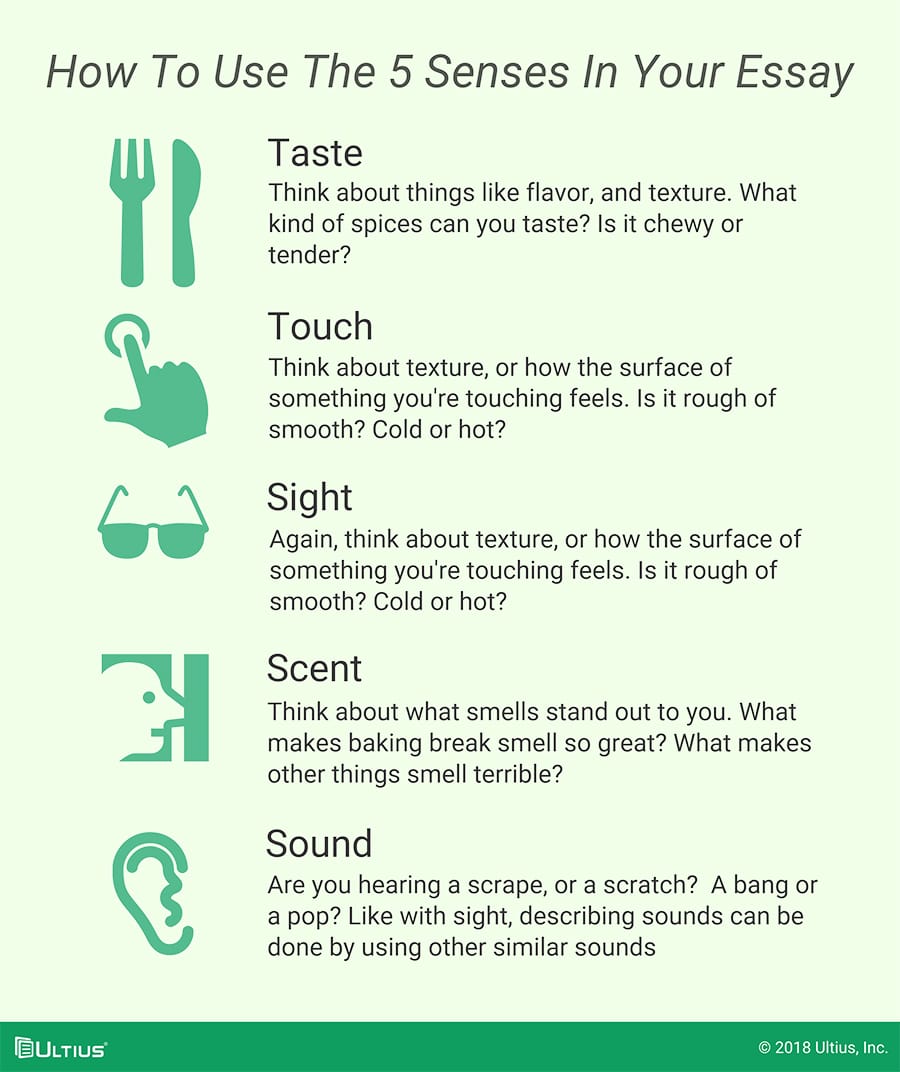
For example, writing a descriptive essay about a place can strengthen your ability to communicate your work expertise to your next potential employer; or to write your life experiences in a compelling way in your next scholarship essay (learn how to write a scholarship essay ).
Perhaps you’d like to write your own book some day or craft your own advertising campaigns using your business degree—both of which are more successful when the reader can empathize with your writing. You’ll use descriptive language to succeed at both!
Choosing a descriptive essay topic
Descriptive essays can be written about many topics. One of the most common assignments you may receive is to write a descriptive essay about a place. Here are a few descriptive writing example topics you might choose:
| Place / Topic | Purpose |
| Favorite vacation spot | To allow readers to understand your personal experiences |
| The house you grew up in | To help readers gain a background understanding of who you are and what growing up was like for you |
| Your place of work | Helping readers understand your daily life |
| Riding a New York subway | Allowing someone who has never experienced this to understand what it feels like |
| Driving through a snowstorm | To enlighten readers to the dangers felt during this experience |
Who writes descriptive essays?
Being able to write well is a skill for any career you're pursuing whether it be business, arts, marketing, education, or even medicine!
Students in these areas will be assigned to write a descriptive essay at some point during their high school or undergraduate careers:
- Language arts students
- Literature and cultural studies students
- Social studies students
- Psychology students
Finding the right words for an engaging essay can be challenging. Plus, many students are pressed for time, juggling work, family, and extracurricular activities on top of trying to complete assignments. If you can identify, this blog will help get you started.

When your future career depends on it, you want to feel confident and proud of your work instead of overwhelmed by it. Practicing smart time management and finding the writing help you need, when you need it, is important.
Elements of a great descriptive essay
Before we dive into how to write a descriptive essay, let’s review some key elements that will help you paint a picture in writing:
Clear organization
Effective descriptive essays are clearly organized. In other words, the reader is able to easily understand why she or he is reading the essay, the place the essay will describe, and what the purpose of the description is. This is accomplished by organizing the essay into and introduction, body and conclusion.
Introduction: A captivating hook
The opening of your essay is one of the most important parts because it interests readers. Start with a captivating introductory paragraph. One way to do this is by using anecdotes to grab readers’ attention. Anecdotes are short stories that can be used literally or metaphorically to help readers relate to what you’re going to write about.
For example, an anecdote that opens an essay with descriptive words about what it’s like to be working in the middle of busy production factory might read:
“Imagine every appliance in your house is turned on—your vacuum cleaner, your blender, your fans—and imagine on top of all that, you hear airplanes and helicopters flying overhead and cars buzzing by outside. Meanwhile, you’re trying to focus on your tasks…”
This type of anecdote accomplishes two key things: First, it engages the reader and helps them personally relate to your essay by asking them to imagine. Second, it immediately clarifies the type of place you’re going to write about.
Build your essay with strong imagery. Capture the time, date, weather, and mood of the place.
The introduction paragraph should end by explaining the place the rest of the essay is going to describe and why. This includes any key setting logistics like time, specific location, and who’s involved.
Body: Full of specifics and adjectives
Anecdotes are also helpful in the body paragraphs of a descriptive essay, for the same reasons noted above. The body of a great descriptive essay about a place should be packed full of vivid, sensory language. During the body of a descriptive essay, the reader gains a clear image and understanding of the place being described, as if he or she were actually there. To accomplish this, the body paragraphs use descriptive adjectives and colorful phrases such as, “The chaotic, clashing noise was deafening,” or, “The scent of freshly fallen rain cleansed the sunlit air, and I could see the horizon for miles.”
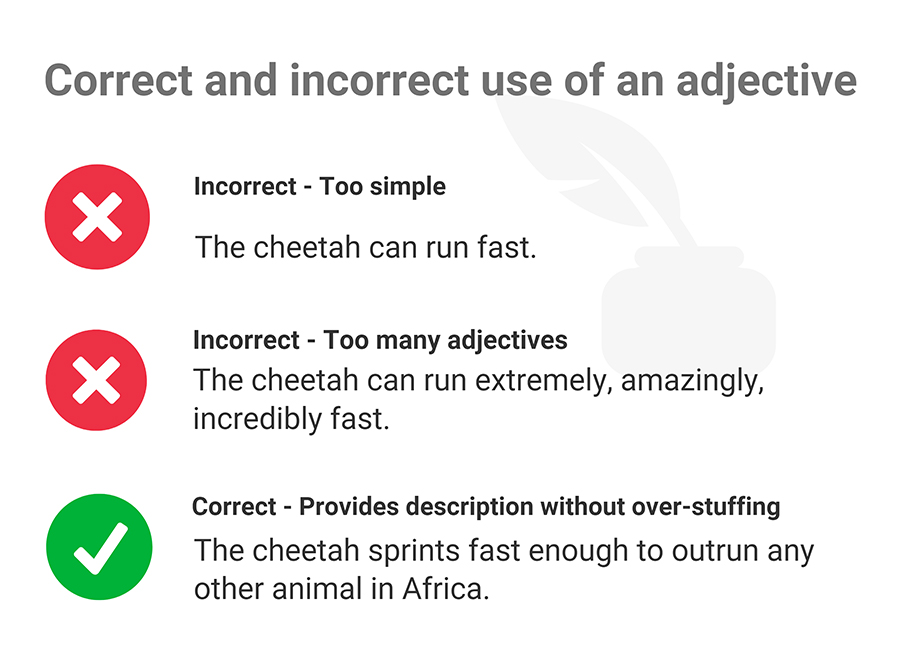
Use one or two strong adjectives to convey descriptions in your sentences. This creates a flow throughout the entire essay. Be sure to note, not every sentence requires an adjective or adverb.
If you’re having trouble with finding adjectives and adverbs, use strong action verbs instead.
Conclusion: Reminding readers of the meaning
Just as the introduction of a descriptive essay previews what place will be written about and why, the conclusion reminds readers of what was just described and why it’s important. The key is to not sound redundant. For instance, while the introductory paragraph hooks readers and then tells them what they can expect to read, the conclusion summarizes what was written and leaves readers with thought-provoking ideas to consider, helping them to understand how the essay may relate to their lives, or why it’s important to the reader.
Revisiting the production factory introduction example, the same essay’s conclusion may summarize with a statement highlighting the essay’s takeaways, such as, “The chaos and noise of the factory made it difficult to focus, but after working there for five years, I learned how to overcome that challenge. Now I can focus in even the most noisy of places.”
Steps to writing a great descriptive essay
1) choose a topic.
Depending on the purpose of your descriptive essay assignment, you may have varying flexibility in terms of what place you can choose to write about. Nonetheless, try to choose a topic that vividly stands out in your memory. The more you can remember about a place and how it felt, the better your descriptive paper is likely to be. For example, if you’re assignment asks you to write about a place you’ve traveled to, what destination comes to mind first? Perhaps it’s a foreign country. Or, if you haven’t traveled much, it could even be a different town.
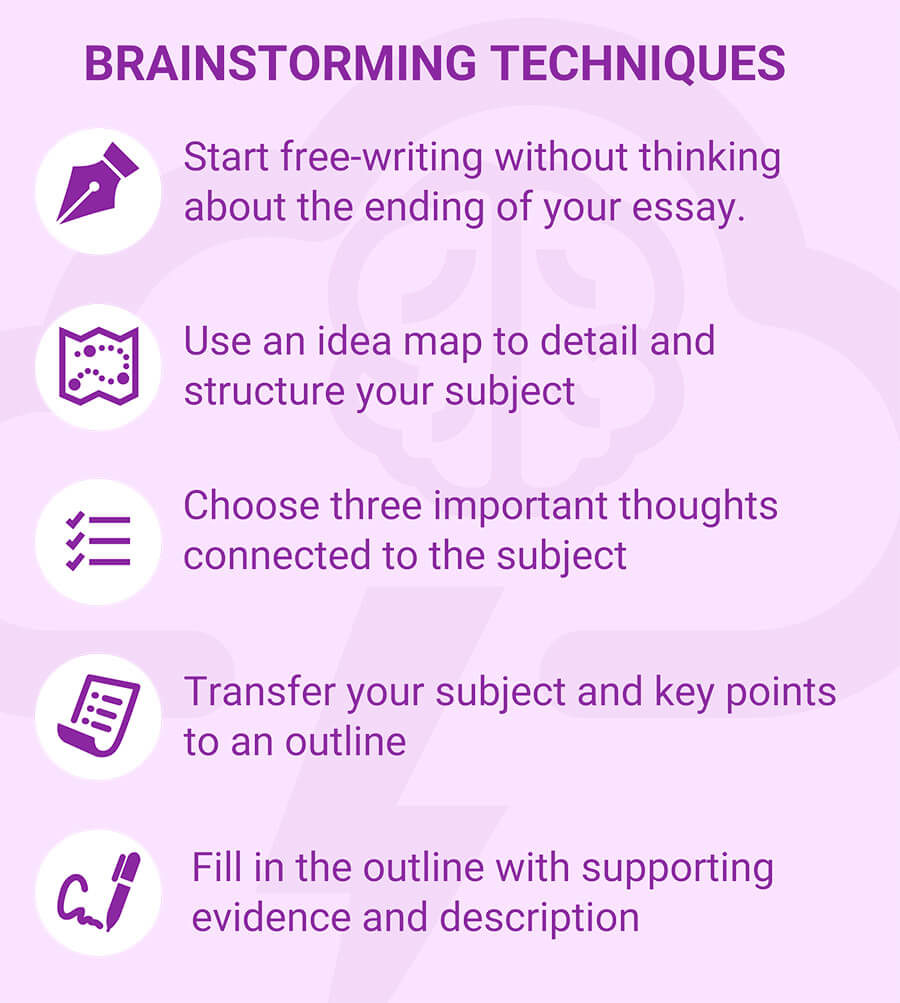
2) Observe the details
If you’re writing about a place you’re currently at or can easily visit, spend time observing the details. Watch what the scenery looks like, including colors and objects. What sounds do you hear? What’s the temperature? What scents do you notice? How do you feel being there? All these questions will help guide your descriptive flow writing process (step six).
If you’re writing about a place you visited in the past, ask yourself the same questions. Perhaps look at old photos to jog your memory. Finally, if you’re asked to describe a place you’ve never been, use your imagination to answer similar questions. The more time you take to list details about what your place feels like, the easier the next steps will be.
3) Understand why your place is important
Ask yourself why you think it is important to share this with your readers. Having a clear understanding of your essays’ importance will not only help you write your introduction and conclusion, but it will also help you stay focused on describing the details that matter most.
4) Outline and organize your writing
Now it’s time to begin the actual descriptive writing process by organizing your ideas into an outline . Your outline doesn’t have to be formal; just a simple numbered list of points to include in your introduction, body and conclusion will suffice. This will guide your writing process and keep you focused.
5) Start with the introduction
Remember step number one and three, “your topic ” and “why your place is important?” Those are the two main highlights you’ll want to make clear in your introductory paragraph. When writing your introduction, be sure it explains what you’re about to describe and why you’re going to write about it.
6) Write the body in free-flow style
The body paragraph of your essay can sometimes be the most difficult part, depending on length, a great way to start is by free-flow writing. This means that you simply start writing your detailed description of the place you’re writing about, without editing or analyzing as you write. This often helps to overcome writer’s block while making sure that all the critical details you jotted down in step two, “observe the details,” get down on paper and into the body of your essay. You’ll be able to go back later and edit the body of your paper for organization, flow and grammar. As long as you start your free-flow within the bullet points of the outline you created, the process will be relatively simple and easy.
7) Revise the body of your essay
Now it’s time to go back and be sure all the free-flow writing you just did is clear, makes sense and follows your original outline. You may need to re-arrange a few sentences or even paragraphs. This is also a great time to check for spelling and grammar errors.
Next, read the body paragraph of your essay and pretend you’re someone else reading it for the first time. How does it sound? Does it make sense and flow? If not, ask yourself what would make your descriptions more understandable for the reader. Finally, remember that not every sentence of your descriptive essay needs to sound fancy, artistic, or be long. Vary your sentence length, breaking up long sentences with short sentences to make reading easier. Use exciting language, but don’t over-do it or adjectives will lose their power.
8) Finish your essay strong
Writing a strong conclusion is key to leaving a lasting impression with your readers. A great way to conclude your descriptive essay about a place is to reiterate, in a new way, how the place you’re describing impacted you and why you believe it’s important. You can also describe what you hope readers may learn from your essay.
9) Proofread your work
You can never re-read your essay too many times. Proofread your work at least twice for spelling and grammar errors. It’s often helpful to read your writing out loud, since that slows the reading process and helps us catch errors we may otherwise overlook.
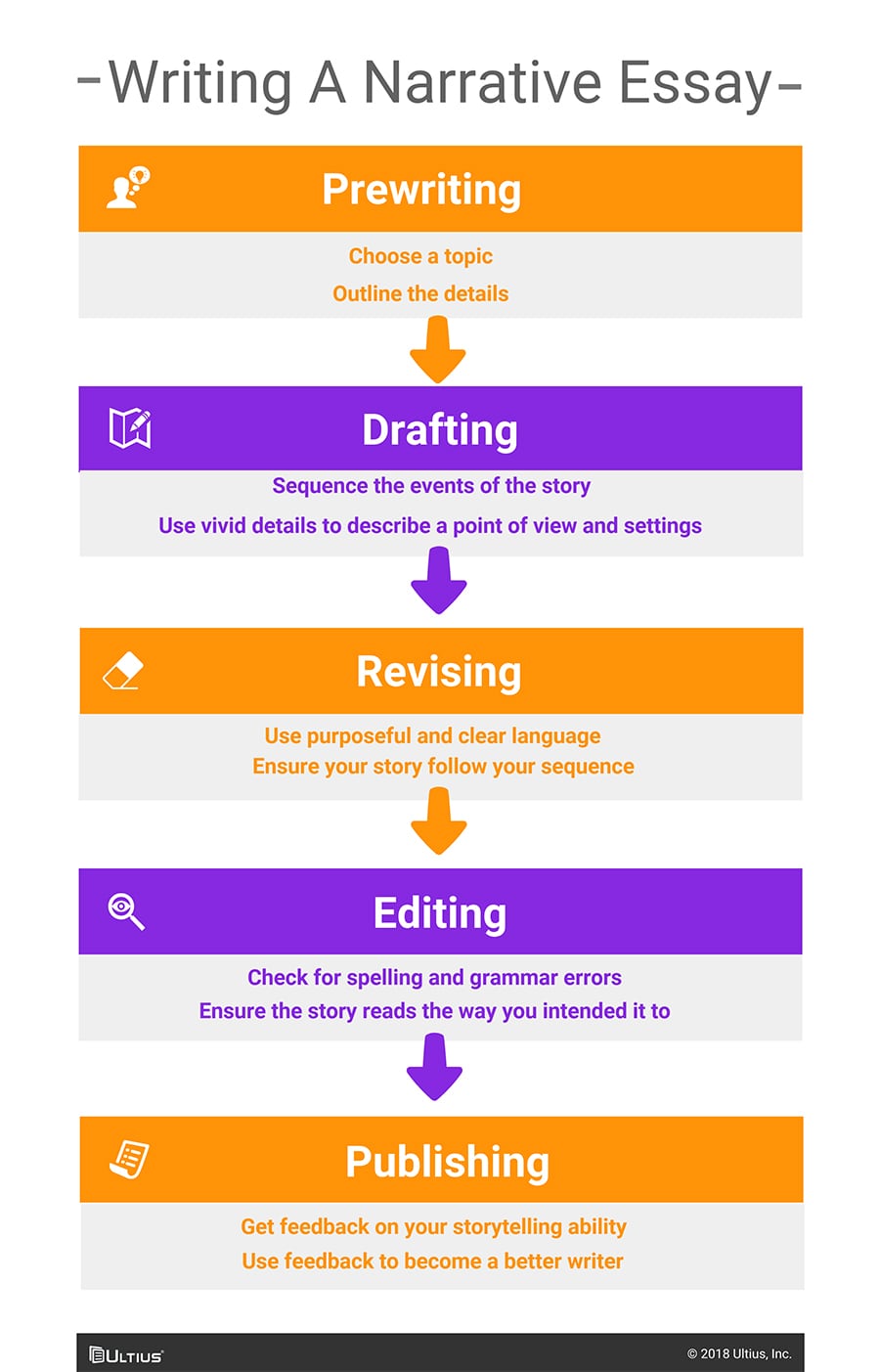
Also, don’t be afraid to ask a friend to proof your work. If you’re still stuck or need help, the writing center has tons of resources just for you like expert advice, essay examples, and more.
Final words of wisdom
| 1) Be specific | The more specific you are, the more readers will be able to relate to your descriptions. For example, “The heat outside made me feel sluggish and exhausted” is a more effective description than, “It was so hot outside.” |
| 2) Write first, edit later | Break writer’s block by writing unedited. You can always revisit your work later, as many times as you need. |
| 3) Remember your adjectives | Descriptions would be lifeless without adjectives! What words can you use to make the place you’re describing come to life?! |
| 4) Include the 5 senses | How does the place you’re describing feel, smell, look, taste and sound? |
| 5) Read from an outsider’s perspective | Pretend you’re your instructor or friend, reading your essay. Does it flow and make sense? |
| 6) Ask for help when you need it | Juggling work, family and other non-school obligations shouldn’t keep you from succeeding academically. Ultius is here to help by providing you with the exact resources you need to save time and put your best foot forward. |
Like what you read? Check out our guide on how to write a persuasive essay .
Discover more
Now you have all the information for how to write a descriptive essay. At Ultius, we offer great features that are unmatched by other competitor's platforms. Learn more about our writing services , browse various customer resources, buy essays and read informative content on our blog .
Stuck with writing?
Ultius can help
Ordering takes 5 minutes
https://www.ultius.com/ultius-blog/entry/how-to-write-a-descriptive-essay-about-a-place.html
- Chicago Style
Ultius, Inc. "How to Write a Descriptive Essay." Ultius | Custom Writing and Editing Services. Ultius Blog, 30 Nov. 2018. https://www.ultius.com/ultius-blog/entry/how-to-write-a-descriptive-essay-about-a-place.html
Copied to clipboard
Click here for more help with MLA citations.
Ultius, Inc. (2018, November 30). How to Write a Descriptive Essay. Retrieved from Ultius | Custom Writing and Editing Services, https://www.ultius.com/ultius-blog/entry/how-to-write-a-descriptive-essay-about-a-place.html
Click here for more help with APA citations.
Ultius, Inc. "How to Write a Descriptive Essay." Ultius | Custom Writing and Editing Services. November 30, 2018 https://www.ultius.com/ultius-blog/entry/how-to-write-a-descriptive-essay-about-a-place.html.
Click here for more help with CMS citations.
Click here for more help with Turabian citations.
Ultius is the trusted provider of content solutions and matches customers with highly qualified writers for sample writing, academic editing, and business writing.

Tested Daily
Click to Verify
About The Author
This post was written by Ultius.

- Writer Options
- Custom Writing
- Business Documents
- Support Desk
- +1-800-405-2972
- Submit bug report
- A+ BBB Rating!
Ultius is the trusted provider of content solutions for consumers around the world. Connect with great American writers and get 24/7 support.
© 2024 Ultius, Inc.
- Refund & Cancellation Policy
Free Money For College!
Yeah. You read that right —We're giving away free scholarship money! Our next drawing will be held soon.
Our next winner will receive over $500 in funds. Funds can be used for tuition, books, housing, and/or other school expenses. Apply today for your chance to win!
* We will never share your email with third party advertisers or send you spam.
** By providing my email address, I am consenting to reasonable communications from Ultius regarding the promotion.
Past winner

- Name Samantha M.
- From Pepperdine University '22
- Studies Psychology
- Won $2,000.00
- Award SEED Scholarship
- Awarded Sep. 5, 2018
Thanks for filling that out.
Check your inbox for an email about the scholarship and how to apply.
Essay Papers Writing Online
How to write a captivating descriptive essay that paints a vivid picture in the reader’s mind.

Have you ever wanted to transport your readers to another world with your writing? To paint vivid images in their minds, evoke powerful emotions, and create a lasting impact? If so, mastering the art of descriptive writing is an essential skill that you simply cannot afford to overlook. Crafting a captivating descriptive essay requires more than just a basic understanding of language – it demands the ability to engage all five senses, to create a sensory symphony that envelops the reader.
Join us on a journey of exploration and discovery as we delve into the nuances of descriptive writing. In this comprehensive guide, we will walk you through the step-by-step process of composing a descriptive essay that will leave your audience spellbound. From selecting a compelling topic to employing effective literary devices, we will equip you with the tools and techniques necessary to bring your writing to life.
Along the way, we will share invaluable tips and tricks gathered from seasoned writers who have mastered the art of description. You will learn how to harness the power of strong verbs and sensory details, infuse your writing with emotion, and create a narrative that lingers in the minds of your readers. So, whether you aspire to become a novelist, a poet, or simply want to enhance your overall writing skills, this guide is your passport to unlocking the secrets of captivating descriptions.
Choose the Perfect Topic for Your Descriptive Essay

When it comes to crafting a descriptive essay, the topic you choose plays a vital role in the overall success of your writing. A well-chosen, engaging topic allows you to capture the attention of your readers and transport them into the world you are describing. In this section, we will explore the various factors to consider when selecting the perfect topic for your descriptive essay.
First and foremost, it’s important to choose a topic that you have a genuine interest in. When you are personally invested in the subject matter, it will naturally shine through in your writing. Whether it’s a place you love, a person you admire, or an experience that left a lasting impression on you, selecting a topic that resonates with you will give your descriptive essay an authentic and enthusiastic voice.
In addition to personal interest, it’s crucial to consider the audience you are writing for. Think about who will be reading your essay and what they might be interested in. Are you writing for nature enthusiasts? Foodies? Travel enthusiasts? Tailoring your topic to suit the preferences of your target audience will help to ensure that your descriptive essay is relatable and engaging to them.
Another important factor to consider when choosing a topic is the availability of descriptive elements. A good descriptive essay is characterized by vivid and sensory details that bring the subject to life. Consider whether your chosen topic has plenty of descriptive elements that you can explore and describe in your writing. For example, if you choose to write about a specific place, consider whether it has interesting sights, sounds, smells, and textures that you can vividly portray in your essay.
Lastly, it’s essential to select a topic that allows for a unique and fresh perspective. Avoid choosing overused or cliché topics that have been covered extensively. Instead, find a unique angle or approach to a common subject that will make your essay stand out. This could involve focusing on a specific aspect or moment within a broader topic, or showcasing a lesser-known aspect of a well-known subject.
By considering your personal interest, the preferences of your audience, the availability of descriptive elements, and a unique perspective, you can choose the perfect topic for your descriptive essay that will captivate your readers and make your writing truly memorable.
Create an Outline for Your Essay
Developing a clear and organized outline is an essential step in the process of crafting a well-written descriptive essay. By creating an outline, you can effectively structure your thoughts and ensure that your essay follows a logical progression. It serves as a roadmap for your writing, allowing you to focus on the main ideas and supporting details that you want to include.
Before beginning your outline, take some time to brainstorm and generate ideas. Consider the main aspects or features of the subject you are describing and think about the specific details that you want to highlight. This brainstorming process will help you establish a strong foundation for your outline and guide your writing throughout the essay.
When creating your outline, start by identifying the main sections or paragraphs of your essay. Each section should focus on a different aspect or feature of the subject. Within each section, include the specific details, examples, or evidence that you want to incorporate to support your description.
Remember to maintain a logical progression throughout your outline and essay. Start with an engaging introduction that provides some background information and sets the tone for your essay. Then, move on to the body paragraphs, which should present the main ideas or features of the subject in a clear and organized manner. Finally, conclude your essay with a thoughtful and concise summary that reinforces the main points and leaves a lasting impression on the reader.
Additionally, consider the order in which you present your ideas within each section. You may choose to present them in a chronological or spatial order, depending on the nature of the subject. Experiment with different arrangements and see which one flows best for your essay.
An outline acts as a roadmap for your essay, allowing you to navigate through the writing process with clarity and organization. By investing time in creating a solid outline, you can ensure that your descriptive essay is well-structured, coherent, and engaging.
Use Sensory Details to Bring Your Writing to Life
Engaging all five senses in your writing is essential to creating vivid and immersive descriptions. By incorporating sensory details, you can transport your readers into the world you are portraying, evoking emotions and allowing them to experience what you are describing.
Instead of simply stating that something is loud, show how the sound reverberates through the air, making your reader’s eardrums vibrate. Instead of writing that a room is cozy, describe the soft texture of the cushions, the warm glow of the fireplace, and the aroma of freshly baked cookies hanging in the air.
When you focus on sensory details, your writing comes alive. Paint a picture with words, allowing your readers to see, hear, smell, taste, and touch the world you have created. Use colorful and descriptive language to appeal to the senses, creating a more immersive and engaging experience for your audience.
Don’t be afraid to get creative and experiment with different sensory details. Think about the atmosphere, the different elements present, and how they affect the senses. How does the rain feel on the skin? How does the scent of flowers linger in the air? These small details can make a significant impact on the reader’s experience.
By incorporating sensory details into your writing, you can elevate your descriptive essay from a mere collection of words to a vibrant and captivating piece of art. So next time you sit down to write, remember to engage all five senses to bring your writing to life.
Organize Your Essay with Clear and Cohesive Paragraphs
When it comes to writing a descriptive essay, it is important to organize your thoughts and ideas in a clear and coherent manner. A well-structured essay not only helps the reader understand your message, but it also showcases your ability to convey information effectively.
One way to achieve this is by using clear and cohesive paragraphs. Each paragraph should focus on a specific aspect or idea related to your topic, providing detailed descriptions and supporting evidence. By dividing your essay into paragraphs, you create a logical flow that guides the reader through your thoughts.
To ensure the clarity and cohesiveness of your paragraphs, it is important to start each one with a clear topic sentence. This sentence should introduce the main idea of the paragraph and serve as a guide for the reader. From there, you can provide supporting details, examples, or evidence that further develop the main idea.
In addition to topic sentences, it is important to use transitional words and phrases to create a smooth transition between paragraphs. These words and phrases help the reader understand the connection between your ideas and how they relate to each other. Some examples of transitional words and phrases include “however,” “in contrast,” “similarly,” and “on the other hand.”
Furthermore, organizing your paragraphs in a logical order can greatly enhance the clarity and cohesiveness of your essay. Consider the most effective way to present your ideas, whether it be in a chronological order, a spatial order, or by importance. This will help the reader follow along easily and understand the progression of your thoughts.
Finally, it is important to conclude each paragraph in a way that summarizes the main points and leads into the next paragraph. This helps to maintain a strong flow throughout your essay and ensures that your ideas are well-developed and connected.
In conclusion, organizing your essay with clear and cohesive paragraphs is essential for conveying your ideas effectively. By using topic sentences, transitional words and phrases, logical order, and effective conclusions, you can create a well-structured essay that engages the reader and showcases your descriptive writing skills.
Show, Don’t Tell: Use Vivid Language and Examples

When it comes to writing a descriptive essay, it’s important to remember the old adage: “show, don’t tell.” This means that instead of simply stating facts or describing something in a straightforward manner, you should use vivid language and examples to bring your writing to life. By using descriptive language, you can create a more engaging and immersive experience for your readers.
One way to bring your writing to life is by using vivid language that appeals to the senses. Instead of simply saying that something is “big,” you can use more descriptive words like “enormous” or “massive.” Similarly, instead of saying that something is “beautiful,” you can use words like “stunning” or “breathtaking.” By choosing words that evoke strong emotions and sensory experiences, you can paint a more vivid picture in the minds of your readers.
In addition to using vivid language, it’s important to provide specific examples to support your descriptions. Instead of making broad statements about a person, place, or thing, try to include specific details that help to illustrate your point. For example, instead of saying that a beach is “peaceful,” you could describe the sound of the waves crashing against the shore and the feel of the warm sand between your toes. By providing specific examples, you can help your readers to better visualize and understand what you are describing.
To further enhance your descriptive writing, you can also incorporate figurative language, such as metaphors and similes. These literary devices can add depth and richness to your descriptions by comparing one thing to another in a creative and imaginative way. For example, instead of simply saying that a sunset is “beautiful,” you could compare it to a painting that is “a fiery masterpiece, with colors that dance across the sky.”
Overall, when writing a descriptive essay, it’s important to use vivid language and examples to bring your writing to life. By creating a sensory and emotional experience for your readers, you can make your writing more engaging and memorable. So, instead of telling your readers what something is like, show them through your use of descriptive language and specific examples.
Revise and Edit Your Essay for Clarity and Conciseness
After completing the initial draft of your detailed composition, it is imperative to carefully review and modify it for clear and precise language. By revising and editing your essay, you can enhance the overall quality of your writing and effectively convey your ideas to the reader.
Begin by carefully reading through your essay, identifying any areas where your language may be unclear or confusing. Look for opportunities to rephrase sentences or clarify ideas, making sure that your message is easily understandable. By using precise vocabulary and avoiding unnecessary jargon or ambiguous terms, you can improve the clarity of your essay.
It is equally important to ensure that your writing is concise and to the point. Review each sentence and paragraph, considering whether any redundant or repetitive information can be eliminated. Aim for brevity, expressing your thoughts in a concise and straightforward manner. Remove any unnecessary qualifiers or excessive adjectives that may detract from the clarity of your essay.
Pay attention to the organization and flow of your essay as well. Check that your ideas are presented in a logical order and that your paragraphs transition smoothly from one to the next. Consider whether any information can be rearranged or added to improve the overall coherence and comprehension of your essay.
After revising for clarity and conciseness, it is crucial to proofread your essay for grammatical errors, spelling mistakes, and punctuation errors. Read through your essay multiple times, checking for any typos or inconsistencies. Consider using online tools or asking a peer to provide feedback to catch any errors you may have overlooked.
By revising and editing your essay for clarity and conciseness, you can enhance the impact of your writing. Ensure that your ideas are effectively communicated and easily understood by making precise language choices and eliminating any unnecessary or confusing information. Take the time to carefully review your essay, and you will be rewarded with a polished and well-crafted piece of writing.
Related Post
How to master the art of writing expository essays and captivate your audience, convenient and reliable source to purchase college essays online, step-by-step guide to crafting a powerful literary analysis essay, unlock success with a comprehensive business research paper example guide, unlock your writing potential with writers college – transform your passion into profession, “unlocking the secrets of academic success – navigating the world of research papers in college”, master the art of sociological expression – elevate your writing skills in sociology.
Descriptive Essay
Descriptive Essay Examples
Last updated on: Nov 20, 2023
Descriptive Essay Examples - 8 Examples To Help You Write Better
By: Cathy A.
10 min read
Reviewed By: Rylee W.
Published on: Dec 31, 2019

Do you need some good descriptive essay samples to understand how these essays work? We are here to help you write a descriptive essay with remarkable success!
So stay with us to learn the basics with the help of some great descriptive essay examples.

On this Page
What is a Descriptive Essay?
A descriptive essay describes and gives sensory details about a person, place, event, or thing in an in-depth and detailed manner. It is different from writing a narrative essay.
The aim of descriptive essay writing is to make the reader feel and see a certain thing, place, or person from your perspective. Your readers may have different points of view about the topic, your job is to make them see what you feel and believe.
These types of descriptions are often found in the literature; novels and dramas, where the writer constricts the whole scene through his or her words.
Ever noticed how you feel like actually seeing the character from a novel in your mind? Or a place? This is the power of a descriptive narrative.
What is the Aim of Descriptive Writing?
The sole aim of a descriptive essay writer is to draw a realistic and actual picture in front of the reader. These essays are a part of high school and college level and students.
Teachers give this type of descriptive writing task to students for developing the students’ skills of describing and explaining something in a detailed manner.
This skill is quite helpful in professional life as the students will know how to analyze something in detail and by considering its different angles.
While writing a descriptive essay can be a fun and enriching experience. Describing your emotions and feelings and dealing with a sensitive topic can be a challenging and daunting task. However, with practice, you can do it successfully.
Good Descriptive Essay Examples
It is not an easy task to write a descriptive essay at first attempt. This is why many students turn to the examples of a descriptive essay to understand its structure and content.
Samples and examples are great to help the students understand how to write certain types of essays. Every essay and assignment is different and, therefore, to score well, you need to be mindful of the content that you add to them.
Effective descriptive essay writing is more about describing different aspects and traits of the chosen subject and the type of feelings they inspire. Commonly, these types of essays describe a particular person, an event, a place, or an emotion with the aim to make the reader feel your way.
Descriptive essay example for grade 6
Descriptive essay example college
Descriptive essay example for university
Don’t give up! Continue reading to explore more amazing examples
Descriptive Essay Example about a Person
Writing about a person is probably the first choice of many students. They like to describe their parents, especially siblings, best friends, and teachers in their essays. However, when you choose to write about a person, it is better that you write about someone who you know.
Descriptive Essay Example about a Person (PDF)
Descriptive Essay Example about an Event
As humans, we come across a number of events and happenings. From casual friends get together to very formal weddings and parties, each one of us has something to talk about.
The descriptive essays about events describe the event, how the writer felt about it along the surrounding details.
Just like we say, a descriptive essay ‘describes’ the topic. In the case of descriptive essay examples about an event, the details will include the kind of event, the level of excitement of the writer, the surroundings, and an overall feeling.
Descriptive Essay Example about an Event (PDF)
Descriptive Essay Example About a Place
Describing a place that you visited in your summer holidays is quite an enjoyable experience. It is like you are visiting the same place again and having the same feelings.
When describing your favorite place in an essay, use vivid language. You can describe the details like the weather of the place, the main place that you visited, the kind of feeling you had.
Descriptive Essay Example about a Place (PDF)
Descriptive Essay Example about Emotions
Describing emotions and feelings is difficult.
Memories, emotions, and feelings are abstract and, therefore, explaining them is not easy. They cannot be explained independently, as you can explain a place or event.
A descriptive essay about emotions includes an event and the feelings associated with it. These could be feelings of sadness, anxiousness, confusion, surprise, and happiness.
Whatever emotions you describe, you can use related adjectives and adverbs to describe them.
Descriptive Essay Example about Emotions (PDF)
Descriptive Essay Example About a Visit
A visit to a doctor, a visit to a zoo, and your first visit to a museum, all make excellent descriptive essay topics.
If you go somewhere for the first time, it is natural to have a plethora of feelings and emotions. These could be feelings of joy and even fear.
Descriptive Essay Example about a Visit (PDF)

Paper Due? Why Suffer? That's our Job!
Descriptive Essay Outline
Like every essay sample, a descriptive essay has an outline and format. The essay follows the traditional essay structure and includes:
1. An Introductory Paragraph
The first paragraph of an essay is the introduction and it usually sets the mood for the entire essay.
A good descriptive essay has a strong opening. It introduces the reader to the main topic and what the essay will be about. However, these details are brief and introduce the main topic only.
Some students think that adding more details in this section will add value to their work. Wrong. It will only minimize their chances of expanding the topic in the main paragraphs and leave them with fewer details.
2. Thesis Statement
A thesis statement tells the reader about the thesis question, based on the topic, and the writer’s claim and main argument. It is written after the introduction and before the main paragraphs.
A thesis statement is written at the end of the introduction, it is mainly a single sentence that describes the essay objective.
3. Body Paragraphs
The body paragraphs take more than half of the entire essay and include all the main claims and arguments of the essay. Generally, it has three paragraphs but depends on the topic and its scope. Some topics may not have much to write about while others may have a wide scope and material.
However, if you feel that your topic does not have much room for expansion, do not try to drag it. It will only ruin its essence and overall feel.
4. Conclusion
A solid closing means a solid essay.
Some students think that because it is a closing paragraph, it requires less focus and is less important. But it is not the case. A clumsy conclusion will leave a bad impression and all your hard work may go to waste.
But, a conclusion is also not a place for new ideas. Stay brief and to the point.
To learn more about descriptive essay structure, you can watch this helpful video
Now that you know the basic outline, you can learn how to write a descriptive essay by visiting our blog and working with those tips and tricks.

Create captivating essays effortlessly!
Descriptive Essay Topics
Got inspired by the examples and looking to write your own essay? So select the topic of your choice from the list below and write a tempting essay…
- The street I love to walk around in
- Exploring the beauty of nature
- The pleasing sounds of rain
- The most meaningful experience I had in college
- Exploring a hidden gem in my hometown
- My favorite book character
- A day spent in my dream destination
- Memories of various festivals I have celebrated
- My favorite food that always brings back memories
- These are some
- The beauty of the rising sun in winter
Choosing a Topic for your Essay
Choosing a topic for your descriptive essay can be difficult and challenging. The reason is there are so many things to write about like
- Relationships
- Favorite place
- Experiences
- Things
- Scenarios and many more.
All of these subjects make great descriptive essay topics. Some quick tips to help you choose a great descriptive essay topic include:
- Choose a topic that interests you
- Choose a topic with a good scope
- Choose something that inspires you emotionally
- Choose a topic that appeals to all five or at least one to two senses
- Choose the topic according to your audience
- Choose a topic that is interesting and will keep your readers glued and engaged
For interesting essay topics and ideas, visit our blog and get 100+ descriptive essay topics to choose from.
Tough Essay Due? Hire Tough Writers!
Elements of a Great Descriptive Essay
Great essays are based on elements relevant to the main topic and explain it in detail. Just like other types of essays, descriptive essays are specifically based on describing the main topic. You can do this by using figurative language and words that appeal to the five senses like touch, taste, sight, etc. of the readers.
Some core elements include:
- Choosing a specific subject:
Choosing the right and appealing subject is essential for a good descriptive essay. Research and make a list of the topics that interest you and see which one you could use for your essay. make sure that you know how to work on that topic before finalizing it.
- Select the Details:
You cannot write about everything. No matter how many details there are, you have to choose the most dominant ones and stick to them closely.
- Organize the Details:
Once you have chosen the details and organize them in chronological order. This step is especially important if you are talking about an event because then you have to add details related to the event.
- Use Descriptive Language:
Descriptive and figurative language is a must if you want to draw a clear picture in front of your readers. Adjectives and adverbs, similes and metaphors, and comparisons are some techniques that you could use to compose your descriptive essay.
- Use Appropriate Language:
Relevant language will help you in presenting the information in a coherent and simple manner. The topic of your essay will decide the kind of language that you will use in your essay.
- Do Not Drag the Essay:
Dragging the essay will do no good for your essay. Writing an engaging essay is essential for successful descriptive essay writing. Coherent, relevant, and engaging facts will add credibility and a natural flair to your essay.
Not sure if you could write an impressive and engaging descriptive essay?
5StarEssays.com is here to help you write an essay . With us, you get high-quality, affordable, and timely help. Our quality assurance is rigid and we make sure all the spelling and grammar checking is done before final submission.
Get in touch with us today and order your essay. Or give our AI essay typer a try to get an essay generated within just 90 seconds!
Frequently Asked Questions
How many paragraphs are in a descriptive essay.
Like any other essay, a descriptive essay also must have at least five paragraphs. The number of paragraphs could increase, based on the scope and need of the topic.
How can I write a good descriptive essay?
Writing a good descriptive essay requires vivid and detailed descriptions, creating an experience for the reader. To do this, it’s important to use clear language that creates images in the reader’s mind.
Additionally, using sensory details can help engage the reader and make them feel as if they are partaking in the experience described.
What are some examples of things you could describe in a descriptive essay?
Examples of things you could describe in a descriptive essay include a location, person, object, or event. Each of these should be explored in detail to help the reader form an accurate mental image.

Finance Essay, Education
Cathy has been been working as an author on our platform for over five years now. She has a Masters degree in mass communication and is well-versed in the art of writing. Cathy is a professional who takes her work seriously and is widely appreciated by clients for her excellent writing skills.
Was This Blog Helpful?
Keep reading.
- Interesting Descriptive Essay Topics Recommended by Experts

- How To Write An Impactful Descriptive Essay?

People Also Read
- types of sentences
- how to write an expository essay
- types of press release
- compare and contrast essay topics
- descriptive essay writing
Burdened With Assignments?

Advertisement
- Homework Services: Essay Topics Generator
© 2024 - All rights reserved
Still have questions? Leave a comment
Add Comment

Checklist: Dissertation Proposal
Enter your email id to get the downloadable right in your inbox!
Examples: Edited Papers
Need editing and proofreading services, guide to a perfect descriptive essay [examples & outline included].

- Tags: Academic Writing , Essay , Essay Writing
A descriptive essay is the most creative of all essay types. It involves the use of sensory descriptors and impactful narratives to depict an object, person, or even something abstract like an emotion. This type of essay is administered by teachers and professors to gauge your understanding of language.
In this article, we will guide you through everything there is to know about descriptive essays. This includes the descriptive essay definition, some descriptive essay topics, and various examples. To help you in your essay-writing process, we have also included an outline of a descriptive essay.
But let’s start from the beginning: What is a descriptive essay?
Perfect your essay with our expert editing services today! Get started
What is a descriptive essay?
A descriptive essay is a highly creative form of writing which describes an object, person, location, experience, emotion, or situation. It makes use of vivid imagery and different figures of speech to create a beautiful and immersive experience for the reader.
This type of essay is often assigned in creative writing courses in schools or colleges. It does not involve the presentation of arguments or information. It just involves creatively expressing yourself with the help of various language devices.
Unlike a narrative essay which involves telling a story, a descriptive essay only focuses on one particular object or idea. Although most essay topics are non-fictional, descriptive essay topics can either be fictional or non-fictional.
Let us look at a few examples of topics for a descriptive essay.
Descriptive essay topics
Since writing a descriptive essay is a creative form of writing, it can cover a wide range of topics. These topics can range from practical experiences such as “My Grandpa’s Couch” to thought experiments such as “Living in a world with no concept of time”.
Here are a few more descriptive essay topics:
- Exploring a ghost town
- A starry night in the mountains
- A day in the life of an explorer
- Trip to the Metropolitan Museum of Art
- Wandering through the Swiss meadows
- My childhood home
- Memories of grandma’s farm
- Experiencing euphoria for the first time
- My description of utopia
- My most treasured possession
Descriptive essay structure
Since descriptive essays are highly creative in nature, the descriptive essay structure is much more fluid as compared to most academic essay types. Although they do follow a general structure, there is no specific descriptive essay format. It serves more as a guideline than a hard and fast rule.
Descriptive essays generally don’t revolve around proving a point or making an argument. The goal is to simply provide a vivid and detailed description of a particular subject.
Let’s study the basic structure of a descriptive essay:
1. Introduction
Wondering how to start a descriptive essay? Like all essay types, the introduction of a descriptive essay is composed of three key elements: A hook, some background information, and a thesis statement.
However, the thesis statement of a descriptive essay is different from the thesis statements of most academic essays. It simply makes a claim regarding the subject of your choosing.
Here’s an example of a descriptive essay introduction:
- Background information
- Thesis statement
The last day of school—a momentous occasion that marks the culmination of a year’s worth of hard work and growth. Excitement hangs in the air as students gather for one final day of shared experiences and unforgettable memories. The hallways buzz with chatter and laughter, mingling with the anticipation of summer freedom. It’s a day of mixed emotions, as the promise of lazy days ahead clashes with the bittersweet farewell to teachers and classmates who have become like family. The last day of school is a mosaic of emotions, a snapshot of a moment that holds the weight of an entire academic journey, and a prelude to the new adventures that lie just beyond the horizon.
2. Body paragraph
A descriptive essay usually has three body paragraphs. However, the length and number of paragraphs may vary depending on the complexity and scope of your essay topic.
A body paragraph comprises of a topic sentence that focuses on a particular aspect of the subject. The topic sentence is elaborated upon by sensory, contextual, and emotional descriptors. Each paragraph ends with a transition sentence that provides context for the next paragraph.
Let’s understand this better with the help of an example:
- Topic sentence
- Description
- Transition sentence
Classrooms brim with finality and accomplishment. Doodles and scribbles now grace once-neat desks, testifying to idle daydreams and shared laughter. Colorful displays and academic achievements adorn the walls, silently witnessing each student’s growth. Empty lockers echo the countless exchanges and whispered secrets they once held. Yearbooks circulate like cherished artifacts, pages filled with smiling faces and heartfelt messages. Laughter and hugs fill the hallways as friends make promises to keep in touch and embark on summer adventures. The last day of school etches indelible memories, a tapestry of nostalgia and celebration that encapsulates the joy, camaraderie, and growth of their academic journey.
3. Conclusion
The conclusion of your essay should begin with the restatement of your thesis statement along with its broader implications. You can then provide a quick summary of all the important aspects mentioned in the body paragraphs.
Finally, you can end your essay with a powerful statement or a clincher. This can include anything from a powerful lesson to a thought-provoking quote. The goal is to leave the reader with something to think about.
Here’s an example:
- Restated thesis statement
- Summary of body paragraphs
- Concluding statement
As the final bell echoes through the hallways and students scatter in all directions, school leaves behind a lingering sense of closure and anticipation. It is a day filled with mixed emotions—a blend of nostalgia for the memories created, gratitude for the knowledge gained, and excitement for the new chapter that awaits. The last day of school symbolizes a milestone in each student’s journey, marking the end of one chapter and the beginning of another. It is a time to reflect on the growth, challenges overcome, and friendships forged along the way. The last day of school is not an end, but rather a stepping stone towards new horizons, where each student will continue to learn, explore, and thrive.
Now that we’ve understood how to structure a descriptive essay, let’s figure out how to write it!
How to write a descriptive essay
In order to write a perfect descriptive essay you must effectively make use of multiple creative writing devices. These creative writing devices include figures of speech, imagery, sensory and emotional descriptors, as well as evocative language.
If you find the essay writing process challenging, we’re here to equip you with essential tips on writing a descriptive essay. Let’s take a look at how to write a descriptive essay:
1. Use figures of speech
Literary devices such as similies, metaphors, and imagery are creative devices that describe an object or a person in a figurative sense. These creative devices add an element of interest to your essay, making it more vivid, vibrant, and colorful.
The use of figures of speech can turn an otherwise boring piece of writing into a masterpiece. Take a look at the following example:
On that spot stood an old banyan tree with thick bark and intertwining branches.
Although this example is a good start, it can be made much more interesting with the use of figures of speech.
On that spot stood an old banyan tree with its resolve as strong as iron. Its arms intertwined as they reached for the skies, yearning for the sun.
The use of literary devices such as personification and metaphor makes the banyan tree in the second example come to life. This is how you can make your writing more vivid, descriptive, and poetic.
2. Use your senses
Sensory descriptors are one of the most important aspects of a descriptive essay. The key is to make the reader experience what you’ve experienced. This means appealing to all five senses of the reader.
Although the visual aspect is important, you should also focus on how something sounds, feels, and smells. The experience of touching, smelling, or feeling something is more evocative than simply viewing it.
Some sensory descriptors are used in a literal sense:
The smell of rain in July takes me back to my childhood. The pitter-patter reminds me of my mother’s footsteps, bringing us delicious snacks.
They can also be used metaphorically:
The beautiful, cold gaze of the moon stunned us all.
3. Use evocative language
It is a good idea to use strong, evocative language that conveys an intense action or emotion. Creative use of words is an important factor in writing a descriptive essay since passive language leads to a dull, boring essay. Let’s take a look at the following sentences:
The 100-meter race was completed by Usain Bolt in under 10 seconds.
Usian Bolt whizzed through the 100-meter race in under 10 seconds!
The use of the word “completed” indicates no action and the use of passive voice makes the example dull. On the other hand, the phrase “whizzed through” indicates speed and intensity which makes the second example much more interesting to read.
Now that we’ve understood the different methods of writing a descriptive essay, let’s understand its outline.
Descriptive essay outline
The outline of a descriptive essay is less structured compared to most academic essay types. It merely serves as a guideline that you can use to flesh out your essay. It also helps you develop a coherent structure and logical flow for your topic sentences.
In order to help you further develop your essay, we’ve created an outline for your reference. The following descriptive essay outline revolves around the nostalgia experienced when going through an old diary.
Turning the Pages of Time
I. Introduction
A. Hook: Engaging opening sentence to grab the reader’s attention.
B. Background: Briefly explain the significance of finding your old diary and the memories associated with it.
C. Thesis statement: Clearly state the main idea of the essay, highlighting the emotional journey of rediscovering your old diary.
II. The discovery
A. Setting the scene: Describe the circumstances and location where you stumbled upon your old diary.
B. Initial emotions: Express the range of emotions that flooded your mind upon finding the diary.
C. Anticipation: Share the anticipation and curiosity about what lies within the pages of the diary.
III. The diary’s contents
A. Opening the pages: Describe the physical act of opening the diary and the smell and texture of the pages.
B. Memories unfolded: Reflect on the memories and experiences captured in the diary entries.
C. Emotional impact: Discuss the emotional response evoked by reading your own words and reliving past moments.
IV. Nostalgic reflections
A. Time traveling: Explain how reading the diary transported you back to the time and place when the entries were written.
B. Reconnecting with your past self: Describe the process of reconnecting with your past self and reevaluating your thoughts and experiences.
C. Lessons and insights: Highlight any valuable lessons, self-discoveries, or personal growth revealed through the diary’s contents.
V. Resonating with present self
A. Relevance to current life: Discuss how the insights and reflections from the diary still resonate with your present self.
B. Perspective shifts: Explain any shifts in perspective or newfound understanding that arose from revisiting the diary.
C. Appreciation: Express gratitude for the diary and its role in preserving and enriching your personal history.
VI. Cherishing the rediscovery
A. Preservation: Discuss the steps you took to preserve and protect the diary after finding it.
B. Future reflections: Share your intentions and plans for continuing the habit of journaling or preserving personal memories.
C. Closing thoughts: Reflect on the lasting impact of finding your old diary and the value of personal reflection and self-expression.
VII. Conclusion
A. Recap: Summarize the emotional journey of rediscovering your old diary.
B. Significance: Emphasize the personal and emotional significance of reconnecting with your past self through the diary.
C. Closing remarks: Conclude with a reflection on the power of personal artifacts and the importance of preserving one’s history.
Now that we have taken a look at the descriptive essay structure let’s look at an example.
Descriptive essay example
To help you better understand the process of descriptive essay writing, we’ve constructed an example. The following example revolves around an imaginary situation. It describes the writer’s voyage through the cosmos.
Exploring the Cosmos
As the rocket engines ignited, the powerful thrust propelled us into the vast expanse of space. The vibrations rattled through the cabin, merging with the palpable anticipation that filled the air. We were embarking on a remarkable journey through the cosmos, leaving behind the familiarity of Earth and venturing into the unknown.
Outside the small window, the twinkling stars grew brighter, casting a mesmerizing glow on the infinite darkness. The view was awe-inspiring as if we were floating amidst a sea of diamonds, each one beckoning us to explore its mysteries. The depth and grandeur of space stretched out before us, reminding us of the minuscule nature of our existence in the universe.
As we traversed through the cosmic void, weightlessness engulfed our bodies, releasing us from the Earth’s gravitational pull. Every movement became a ballet, effortlessly gliding from one corner of the spacecraft to another. The sensation was both exhilarating and disorienting as if the boundaries of physical limitations had dissolved.
The silence in space was profound, a symphony of tranquility. Without the interference of atmospheric sounds, we were left with the gentle hum of the spaceship’s systems and the rhythmic beating of our own hearts. It was a humbling reminder of the vastness and serenity that lay beyond our home planet.
Farther into our journey, celestial bodies came into view, captivating us with their sheer beauty. The fiery hues of neighboring planets illuminated the darkness, displaying their own distinct personalities. We marveled at the majestic rings of Saturn, a delicate masterpiece encircling the giant planet, and the crimson swirls of Jupiter, a tempestuous giant with its own cosmic dance.
Time seemed to lose its grip on the vastness of space. Hours felt like mere moments as we traveled through light-years, witnessing the unimaginable beauty of celestial phenomena. We were reminded of the sheer magnitude of the cosmos, a testament to the wonders that lie beyond our earthly confines.
Eventually, the time came for us to return to our home planet. As we reentered Earth’s atmosphere, the fiery descent illuminated the sky, marking our triumphant return. The journey through space left an everlasting mark on our souls, forever changing our perception of our place in the universe.
Our journey was more than a physical exploration; it was a voyage of wonder and introspection. It taught us the fragility and interconnectedness of all things and ignited an insatiable curiosity to continue unraveling the mysteries of the cosmos. We were forever transformed by the immensity and beauty that awaited us beyond our pale blue dot in the vast expanse of space.
After writing the essay, it’s important to edit and proofread it, which is a not easy. If you find essay editing challenging, you can consider taking the help of an essay editing service .
Want to keep reading? Here are the newest articles we’ve worked on:
- How to Start an Essay
- Expository Essays | Step-by-Step Manual
- How to Write an Argumentative Essay
- Types of Essays
- Compare and Contrast Essay
Frequently Asked Questions
What is the purpose of a descriptive essay, how to conclude a descriptive essay, how long should a descriptive essay be, what are the five parts of a descriptive essay, what are the two types of descriptions.
Found this article helpful?
Leave a Comment: Cancel reply
Your email address will not be published.
Your vs. You’re: When to Use Your and You’re
Your organization needs a technical editor: here’s why, your guide to the best ebook readers in 2024, writing for the web: 7 expert tips for web content writing.
Subscribe to our Newsletter
Get carefully curated resources about writing, editing, and publishing in the comfort of your inbox.
How to Copyright Your Book?
If you’ve thought about copyrighting your book, you’re on the right path.
© 2024 All rights reserved
- Terms of service
- Privacy policy
- Self Publishing Guide
- Pre-Publishing Steps
- Fiction Writing Tips
- Traditional Publishing
- Additional Resources
- Dissertation Writing Guide
- Essay Writing Guide
- Academic Writing and Publishing
- Citation and Referencing
- Partner with us
- Annual report
- Website content
- Marketing material
- Job Applicant
- Cover letter
- Resource Center
- Case studies
WTO / Education / How to Write a Descriptive Essay (12 Best Examples)
How to Write a Descriptive Essay (12 Best Examples)
A Descriptive Essay is a category that describes something such as a place, object, experience, situation or emotion, etc, in a detailed and vivid manner.
It requires the writer to use his/her creative writing ability to paint a picture in the reader’s mind by providing a comprehensive account of the experience. This essay is often assigned to students in high school and in composition classes.
The writer of a descriptive essay has the creative freedom to use precise language to describe his/her subject/topic.
12 Best Descriptive Essay Examples
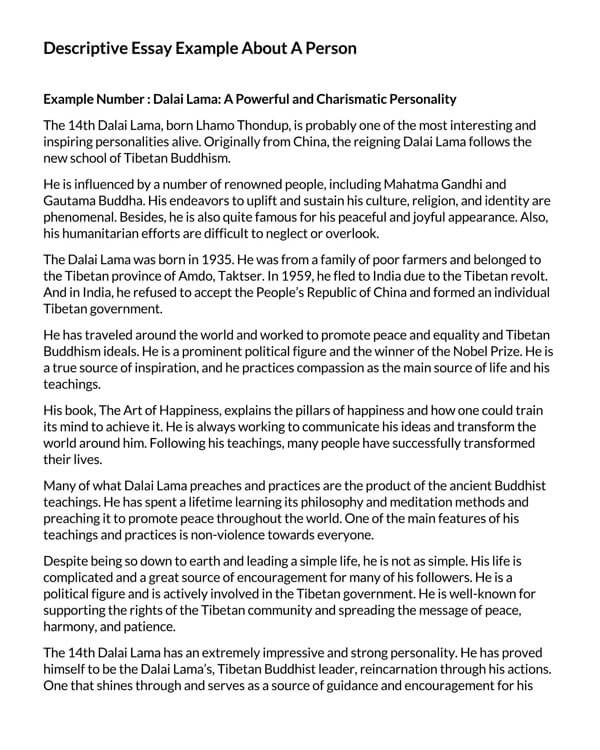
Purpose of Writing a Descriptive Essay
A descriptive essay enables writers to immerse their audience in their words with sensory details . It also enables writers to capture and share events with their audience vividly. The figurative language used in these essays helps the reader understand the writer’s story through visualisation, making the content more interesting to write or read. These essays also give writers almost unrestricted freedom of choosing the meaning of expressions through their sentence composition.
Type of Topics in a Descriptive Essay
These types of essays are a powerful way for writers to communicate their experiences. However, they must first decide what they are going to write about. The topics writers explore will help them plan out how they will write the essay.
Writers can therefore consider the following types of topics in a descriptive essay:
Personal descriptive essay
These essays detail a writer’s personal experience . The writer may describe an event, person, place, or object they love or care for. They provide a first-hand account of their experiences, making it a descriptive narrative that relies more on their memory than research.
It was past midnight, and I was sound asleep when I heard it, a subtle crackle of my living room floor. I sat up on my bed, opened my eyes to the pitch-black darkness of my room, my back open to the relative cold, I waited, hoping that it was nothing, but then I heard it again. My heart was pounding, but I had to find out who or what that was. So I slowly, carefully, and quietly tiptoed my way to my bed.
Imaginative descriptive essay
An imaginative descriptive essay details a fictional, historical, or fantastical situation. It can discuss anything from travel to civil rights.This essay is based on fiction, requiring the writers to depend on their creative ability to bring the essay to life.
The sky was still empty, not a single star, nothing but the bright shimmering light of the moon. The only reason it shone so bright was that it was inching ever so close. They walked along the river bed surrounded by a thick wilderness of trees, exhausted, but they couldn’t stop; they could feel it haunting them, slowly preying on them in the thick trees waiting for one of them to drop their guard.
Conceptual descriptive essay
This essay details a writer’s exploration of ideas and emotions. The writer is expected to carefully explore the concept and formulate a concise, exciting thesis. The sole purpose of the ideas explored in a conceptual descriptive essay is to provide a clear definition explanation.
Depression, it’s an empty, isolating, and hopeless feeling. Some days the heart is in a weightless existence, and then there are those days. Days when there is nothing but an overwhelming feeling of pain. It entraps you in your own body, and some say it as if they walk around with an open wound on their chest.
How to Write a Descriptive Essay
Writing this essay requires a writer to be creative and expressive. Therefore, the writer must follow a step-by-step process to ensure that the content is effectively conveyed.
Writers should consider adhering to the following process when writing a descriptive essay:
Select a specific topic
When writing a descriptive essay, writers should first select a topic that enables them to use colourful language and provides them with creative freedom. Writers must also consider who their readers are to ensure the topic aligns with their reader’s interests. The writer can then decide on a topic and write a thesis statement that will summarise their concept.
Collect information
Secondly, writers should collect information concerning the topic. Collecting information for essays can help writers find details that can be used during the writing process. Therefore, writers can provide vivid details concerning how an event occurred or the characteristics of the person, place, or object. The information also helps strengthen the essay’s contents by enabling the writer to provide names and dates.
Make an outline
Thirdly, an outline of the main points should be made. Outlining enables the writer to categories the information collected into individual paragraphs ahead of writing. This enables writers to plan and manage their writing time and identify what they cover. It also ensures that writers can focus on the main points covered in the essay’s body paragraphs.
Write an introductory paragraph
Next, such an essay must have an introductory paragraph. The thesis statement should be a part of the introductory paragraph. A good introductory paragraph should capture the reader’s interest in the descriptive essay.
Writers can use rhetorical questions or bold statements in the introductory paragraph to hook their readers. Using rhetorical questions in the introduction adds creative flair to the essay, while a bold statement draws extra attention to the provided information.
Write body paragraphs
The writer must then ensure that each paragraph of the main body of the essay has a topic sentence. The topic sentence spotlights the main idea of the paragraph, therefore, informing the reader of what it is about. A topic sentence also unifies the contents of the paragraph, therefore, ensuring a coherent order of sentences.
Concluding paragraph
The final paragraph of an essay should be an overall summary, drawing all the points together. Writers should use the final paragraph to reaffirm the essay thesis, indicating to their readers that they have achieved the essay’s goal. This paragraph is also the writer’s last chance to impress the reader.
Proofread your essay
Finally, once the writing is complete, writers must read the first draft of the descriptive essay to ensure its error-free. Proofreading also helps ensure that writers have properly conveyed their ideas, ensuring that the essay is of high quality.
Descriptive Essay Example
Descriptive essay about “a place i love”.
I have always been fascinated with the great outdoors. A place like the Amazon rainforest, a vast tropical wilderness of trees with relatively small inclusions of vegetation like the savanna, grasslands, swamps, bamboos, and palm trees. This beautiful, luscious forest can be enormous, gentle, and sometimes scary.
I have enjoyed the beauty of nature since childhood; being in places like the Amazon has provided me with surreal experiences. However, to be in a vast forest that covers an area roughly the size of the USA, making it the largest rainforest on earth, is incredible. Walking through thick, moist vegetation and sometimes finding ourselves surrounded by an army of cutter ants hard at work with leaves on their backs as they march down the highway of trees was both scary and wonderful.
The warm climate of the amazon made wearing heavy clothing like jackets unnecessary and frankly impossible except at night when the temperature would drop dramatically. This warm climate makes the Amazon ideal for pesky tiny mosquitos; therefore, mosquito repellant is essential for anyone who visits. However, nothing could beat the fresh air filled with the smell of palm trees and wood.
When I first visited the Amazon, the paths weren’t defined; therefore, we had to use machetes to make our way through different jungle parts. However, one of the most incredible breathtaking moments was watching the sunset in an iron-made tower about 37 meters high where we could see the treetops.
To summarize my visit to the Amazon, the experience can only be fully described as wild, unforgettable, and sometimes even emotional. In the Amazon, nature meets beauty making the experience an inseparable part of the self.
Writers should consider going through descriptive essay examples before writing. Descriptive essay examples help writers understand how they can write certain types of essays. They also expose writers to good ideas, writing styles, and essay structure. Writers can also note down mistakes made by other authors , therefore, enabling them to improve the contents of their essays.
Writing Tips for a Descriptive Essay
When writing such an essay, writers should ensure they have a goal in mind. The goals set will help them assess if communication was effective or not. Setting goals will also help them form their thesis statement enabling them to establish their argument.
Writers should therefore consider the following tips when writing a descriptive essay:
Spend some time brainstorming
Once a topic for the descriptive essay has been selected, the writer should brainstorm by writing down some ideas about it. The writer can write down a few points breaking down the topic or key information about an experience that he/she wants to include in the essay. Brainstorming will help inspire creativity and enable the writer to compile a descriptive list for each word/piece of information.
Use of clear and concise language
This essay should be written in clear and concise language. This ensures that the content remains to the point. It also helps ensure that the writer sustains the reader’s attention. Using clear and concise language leaves no room for interpretation due to efficient communication by the writer.
Use of figurative and vivid language
This essay should enable the reader to visualize the contents on the page; this makes it necessary for the writer to use figurative and vivid language. Figurative language enables writers to use phrases that go beyond the literal meaning by using devices such as similes and metaphors.
This helps make the essay memorable, especially when the devices are used in an original manner. The use of vivid language such as a stroll in place of a walk can serve a distinct purpose of forming a firm image of the action in the reader’s mind.
Use your senses
The use of the writer’s senses during writing brings the content to life. Sensory details like sight, sound, smell, taste, and touch helps the writer form an image or evoke an emotion in the reader’s mind. It also helps the writer engage with readers’ human experiences, making them feel a part of the story.
Choose the right words
Each word used in an essay makes an impression on the reader; therefore, writers should carefully choose their words. The words used by the writer help the reader emotionally connect with the writer’s experience. The right words also help give credibility to the writing because readers can discern content written in clarity.
Relate the essay to what you were thinking
The contents of a descriptive essay should relate the thoughts of the writer with that of the reader. This helps create a connection between the two parties. Emotionally connecting with readers keeps them hooked to the essay and helps ensure effective communication of content.
Make a long-lasting an impression
A writer should strive to make a long-lasting and clear impression on the reader because the experience was effectively communicated. Writers are also able to evoke reader’s interest in their other essays. The impression writers make using this essay also enables them to impact the reader’s opinions.
If a writer’s essay describes a horrible experience with dolphins, readers are likely to fear encountering one.
Be organised
A descriptive essay should be organised to make it easier for the reader to understand the writer’s thesis. The organisation also makes it easier for the writer to put the essay together. Being organised ensures the flow of information between the writer and the reader; therefore, the essay’s goal is reached.
Frequently Asked Questions
Writers can select a descriptive essay by first deciding on a topic that they would like to cover. The topic can be chosen by thinking of a specific place, situation, experience, person, or emotion that the writer can interestingly describe. The topic may also have personal significance to the writer. When selecting a topic, the writer should ensure that he/she can provide a detailed description using particular features. If the topic is general or vague, it may disinterest the reader.
A descriptive essay has an introduction that must contain a thesis statement at the end, body paragraphs, and a conclusion. The body paragraph of an essay provides more details, while the conclusion reaffirms the essay thesis.
The key to writing a descriptive essay is a vivid description that enables readers to form a comprehensive picture of the events on the page. In addition, the description used enables the writer to appeal to the emotions of the reader.
About This Article

Was this helpful?
Great! Tell us more about your experience
Not up to par help us fix it, keep reading.

Education , Guides
How to write a narrative essay (12 best examples).

35 Free Essay Outline Templates | How to Write (9 Types)

7 Best Research Paper Outline Examples (Guide + Tips)

Argumentative Essay Outline Format [12 Best Examples]

How to Write an Expository Essay? (16 Best Examples)

12 Functional Behavioral Assessment (FBA) Examples

Education , Lists
25 free reference page (sheet) templates – word | pdf.

How to Write an Essay Outline (21 Examples – Templates)
Thank you for your feedback.
Your Voice, Our Progress. Your feedback matters a lot to us.
Home — Essay Samples — Life — Place — Descriptive Essay On My Favourite Place
Descriptive Essay on My Favourite Place
- Categories: Place
About this sample

Words: 514 |
Published: Mar 14, 2024
Words: 514 | Page: 1 | 3 min read

Cite this Essay
Let us write you an essay from scratch
- 450+ experts on 30 subjects ready to help
- Custom essay delivered in as few as 3 hours
Get high-quality help

Verified writer
- Expert in: Life

+ 120 experts online
By clicking “Check Writers’ Offers”, you agree to our terms of service and privacy policy . We’ll occasionally send you promo and account related email
No need to pay just yet!
Related Essays
3 pages / 1502 words
1 pages / 400 words
1 pages / 421 words
2 pages / 819 words
Remember! This is just a sample.
You can get your custom paper by one of our expert writers.
121 writers online
Still can’t find what you need?
Browse our vast selection of original essay samples, each expertly formatted and styled
Related Essays on Place
"It's That It Hurts" is a poignant short story by Tomas Rivera that delves into the profound themes of cultural displacement, identity, and the struggles of assimilation faced by Mexican-American immigrants in the United [...]
Throughout our lives, we encounter places that leave an indelible mark on our memories and hearts. This essay delves into the concept of memorable places, examining the reasons behind their significance, the emotions they evoke, [...]
The Capilano Suspension Bridge is located in one of the remote and natural places in the U.S., away from urban noises. The area offers a tranquil environment that has been cherished since childhood. It is nestled on the edge of [...]
A location profile essay is a detailed description of a particular location that includes its history, culture, landmarks, economy, and challenges. This essay aims to profile a location by providing readers with comprehensive [...]
One thing that always motivates me to go the beach is its power to relax me. It’s not very often that you get to see a sunrise-gold seashore in a morning like this. That, however, was my privilege as I stared at the foamy sea. [...]
Madrid, Barcelona, Costa Brava, Seville, San Sebastian and Andalusia, Valencia, can stay during your stay in Marbella and Pamplona - the best places and cities that can be visited in Spain insider guide. Madrid You can [...]
Related Topics
By clicking “Send”, you agree to our Terms of service and Privacy statement . We will occasionally send you account related emails.
Where do you want us to send this sample?
By clicking “Continue”, you agree to our terms of service and privacy policy.
Be careful. This essay is not unique
This essay was donated by a student and is likely to have been used and submitted before
Download this Sample
Free samples may contain mistakes and not unique parts
Sorry, we could not paraphrase this essay. Our professional writers can rewrite it and get you a unique paper.
Please check your inbox.
We can write you a custom essay that will follow your exact instructions and meet the deadlines. Let's fix your grades together!
Get Your Personalized Essay in 3 Hours or Less!
We use cookies to personalyze your web-site experience. By continuing we’ll assume you board with our cookie policy .
- Instructions Followed To The Letter
- Deadlines Met At Every Stage
- Unique And Plagiarism Free

Descriptive Essay
Descriptive essay generator.

Essays are written due to various reasons and purposes. Some of the authors want to inform, some want to expose while some want to persuade. However, in descriptive essay writing , the essayist composes for the sake of displaying a picture out of his/her describing words. It may sound easy and simple but don’t be deceived, there are still more to learn. Read through this article to get hold of significant and beneficial new knowledge.
What is Descriptive Essay? A descriptive essay is a type of writing that aims to vividly describe a person, place, object, or event. In this type of essay, the writer uses sensory details such as sight, sound, smell, taste, and touch to create a clear and vivid image in the reader’s mind. The goal of a descriptive essay is to evoke a strong emotional response or create a vivid impression of the subject being described.
Descriptive Essay Format
Introduction.
Hook: Start with a sentence that captures the reader’s attention. This could be a striking fact, a question, or a vivid description. Context: Provide some background information to set the scene. Describe the setting, the situation, or the object of the essay. Thesis Statement: End the introduction with a clear thesis statement that outlines the main aspects or the overall impression of your subject.
Body Paragraphs
Each body paragraph should focus on a specific aspect or a detail that contributes to the overall picture you are trying to paint. Use the “show, don’t tell” technique by employing vivid imagery and sensory details.
Paragraph 1: Sight
Topic Sentence: Introduce the aspect of sight. Details: Describe what you see in vivid detail. Use adjectives and adverbs to bring the scene to life. Closing Sentence: Wrap up the paragraph by summarizing the importance of the visual details.
Paragraph 2: Sound
Topic Sentence: Focus on the sounds related to your topic. Details: Describe what can be heard, whether it’s the background noise, a specific sound related to the subject, or the absence of sound. Closing Sentence: Conclude by explaining how the sounds contribute to the overall impression.
Paragraph 3: Smell
Topic Sentence: Highlight the aspect of smell. Details: Describe the aromas and scents. Whether it’s pleasant or pungent, detail how it impacts the scene or the subject. Closing Sentence: Summarize how the smell adds to the depth of your description.
Paragraph 4: Touch
Topic Sentence: Discuss the sense of touch. Details: Describe the textures and temperatures. Explain how something feels to the touch and why it’s important to your description. Closing Sentence: Link the tactile details to the overall experience.
Paragraph 5: Taste (if applicable)
Topic Sentence: Introduce the sense of taste, if relevant. Details: Describe the flavors and the experience of tasting something related to your subject. Closing Sentence: Reflect on how taste enhances the description.
Summary: Briefly restate your thesis and summarize the main points of your essay. Significance: Explain the significance of the subject and the impact it has made on you or the impression it leaves. Closing Thought: End with a final thought or reflection, leaving the reader with something to ponder.
Example of Descriptive Essay
“The Sunset at the Beach” As I walked down the sandy path towards the ocean, the first thing that struck me was the vast expanse of the sea, stretching endlessly towards the horizon. The sun was beginning to set, painting the sky in shades of orange, pink, and purple. The beauty of the sunset at the beach was a breathtaking spectacle that I had come to witness. Introduction The beach has always been a place of serenity for me, especially during the sunset. The way the sun dipped below the horizon, leaving behind a tapestry of colors, always seemed magical. On this particular evening, the scene was set for a perfect display of nature’s artistry. Body Paragraphs The Vision of the Sunset As I stepped onto the soft, warm sand, my eyes were immediately drawn to the horizon. The sun, a fiery orb, was slowly descending, casting its golden glow across the sky. The clouds, mere wisps earlier in the day, now looked like cotton candy, stained with hues of pink and lavender. The reflection of the sunset on the water added a layer of brilliance to the scene, with the light dancing on the waves as they gently lapped against the shore. The Symphony of the Waves The sound of the waves provided a soothing background melody to the visual spectacle. Each wave crashed against the shore with a rhythm that was both calming and invigorating. In the distance, seagulls called to one another, their cries adding to the orchestral performance of nature. The rustling of the palm leaves in the gentle breeze played a soft, whispering harmony, creating a symphony that only the beach at sunset could offer. The Aromatic Breeze With every breath, the salty tang of the sea air filled my lungs, a distinctive aroma that immediately relaxed my body and mind. There was a freshness to it, a reminder of the vast, untamed ocean before me. Mixed with the faint scent of sunscreen and the earthiness of wet sand, the beach’s aroma was invigorating, grounding me in the moment. The Touch of Nature As I walked along the water’s edge, the cool water washed over my feet, providing relief from the day’s residual heat. The sand, now cooler than the afternoon sun, felt soft and comforting beneath my toes. Occasionally, a stronger wave would rush further up the beach, encouraging me to dig my feet into the sand, feeling the grains shift against my skin. Conclusion The sunset at the beach was not just a visual masterpiece; it was an experience that engaged all the senses. As the sun finally disappeared, leaving behind a sky painted in dark blues and purples, I felt a sense of peace and contentment. The beach at sunset had offered me a moment of beauty, tranquility, and a deep connection with nature. It was an unforgettable scene, etched in my memory, reminding me of the simple, yet profound joys of life.
Descriptive essays generally focus more on visualizing a specific topic of interest. Considering that aspect, showing you what it looks like may be helpful as well. Thus, we cautiously gathered the best samples and templates of descriptive essays for you to rely on, here are they:
Bright Topic Ideas for Your Descriptive Essay
The list of the possible topic ideas for your descriptive essay is limitless. There are a lot of choices to choose from and sometimes, it is really difficult to pick one. If you are being indecisive regarding your topic idea, here are some smart concepts to help you select one.
Descriptive Essay Ideas About People
- Description of your favorite music genre
- Treating a popular villain as a good protagonist
- The right words that would compliment your singing idol
- Why your squad is the best?
- What qualities should your future spouse possess?
- Why your aunt is the best?
Descriptive Essay Ideas About Places
- Why Manila Bay has the best sunset?
- The perfect adjective to describe your hometown
- Details on your recent vacation destination
- Why your favorite coffee shop is worth the visit?
- What makes Paris unique?
- The best description for your workplace
Descriptive Essay Ideas About Things
- Why your wedding ring is the most luxurious?
- The description of your favorite blanket
- What makes your research paper great?
- Description of your proposed food product
- Perfume: more than just the bottle
- Why your bag is great
Descriptive Essay Examples & Templates
Descriptive narrative essay example.

Descriptive Essay Outline Example

Short Essay Plan Example
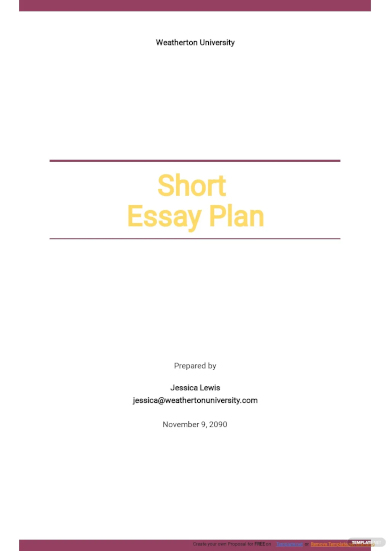
Biographical Narrative Essay Example

College Narrative Essay Example
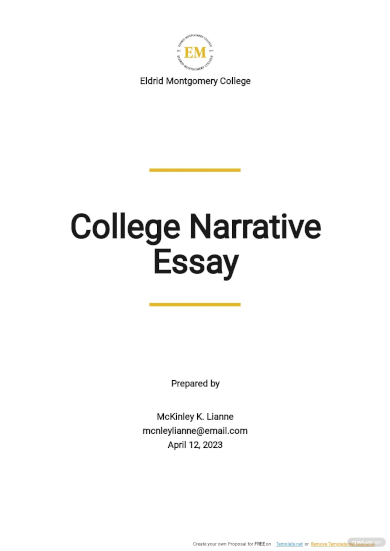
Personal Narrative Essay Example

Short Narrative Essay Example
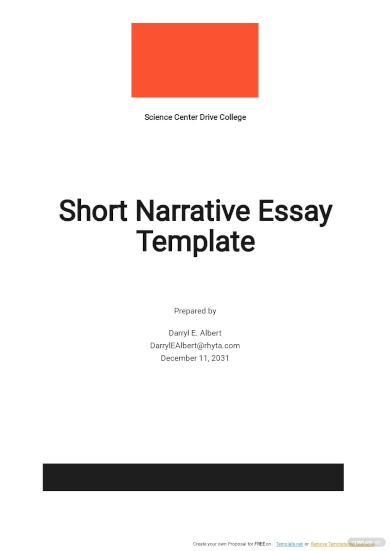
High School Descriptive Essay Example

Free Simple Descriptive Essay Plan
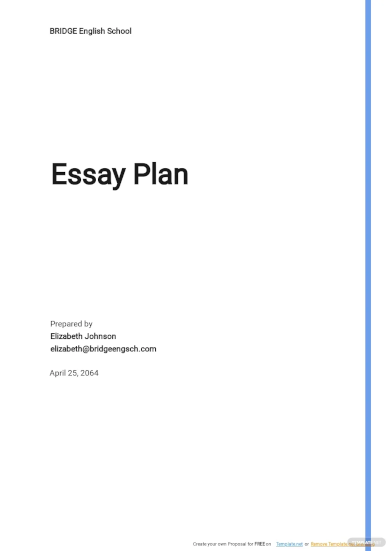
Basic Descriptive Essay Writing Example

latterdaylearning.org
Short Descriptive Essay Example

trudyamiller.wikispaces.com
Descriptive Essay Structuring Example
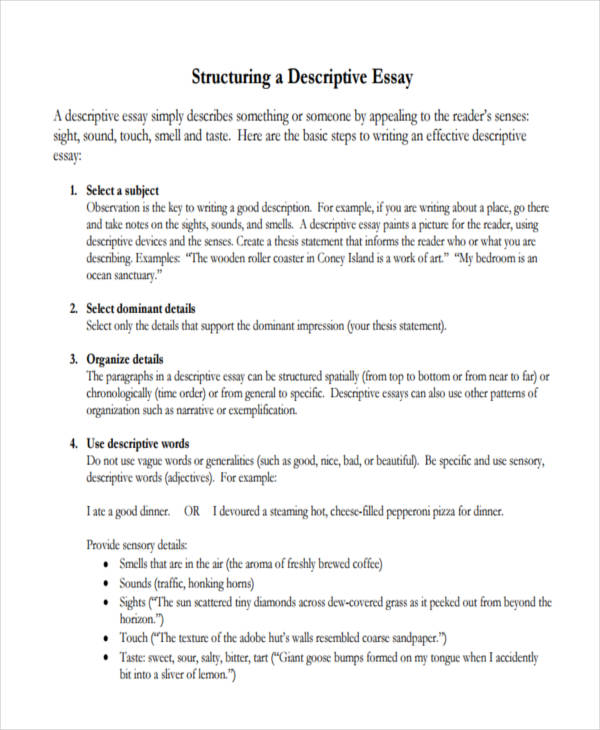
colegiobennett.org
Simple Descriptive Essay Example
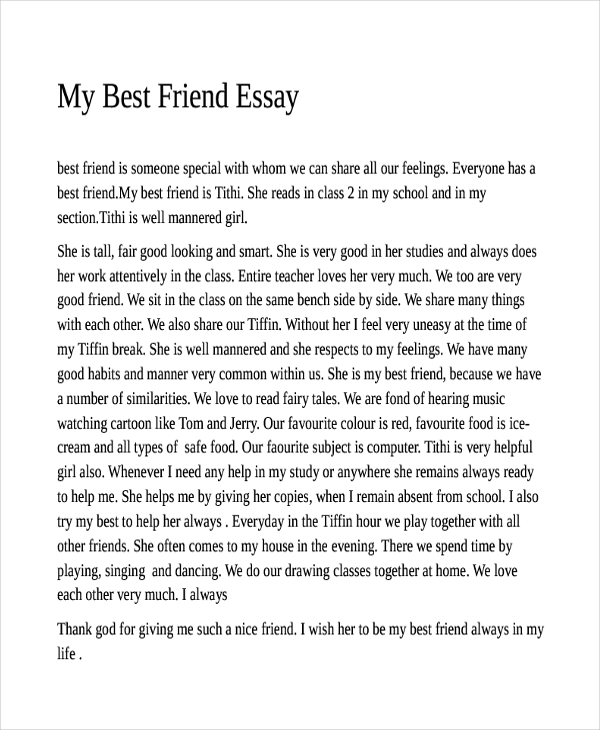
essssay.com
Narrative Descriptive Essay Example

preservearticles.com
Descriptive Essay Prewriting Example

fileserver.net-texts.com
Personal Descriptive Essay Example
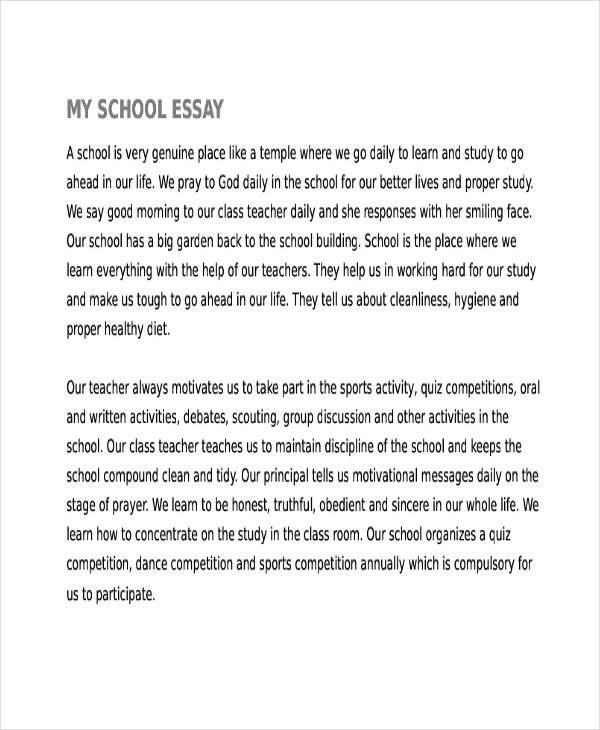
indiacelebrating.com
Descriptive Essay Characteristics Example

Descriptive Essay Description Guide Example
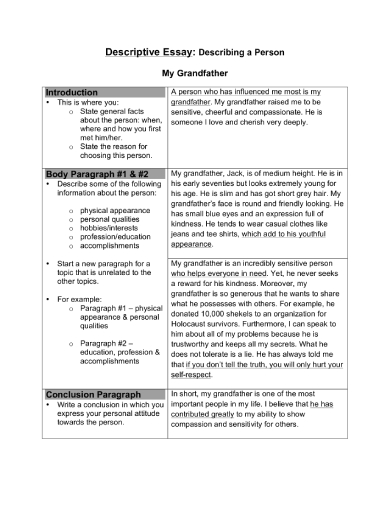
ortbinyaminaenglish.yolasite.com
Descriptive Essays about Places Example
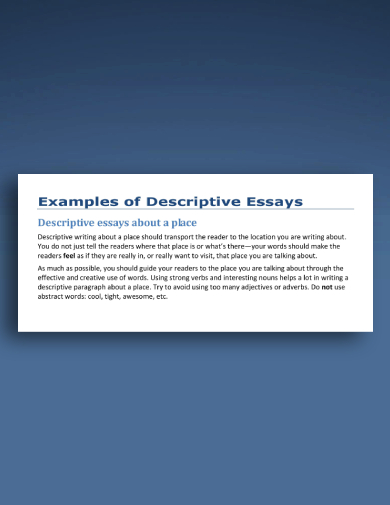
Excellent Descriptive Essay Example
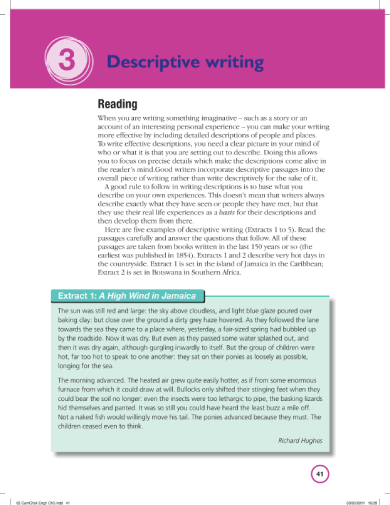
hoddereducation.co.uk
Descriptive Essay Writing Exercise Example

Educational Descriptive Essay Example

owll.massey.ac.nz
Spring Break Descriptive Essay Example
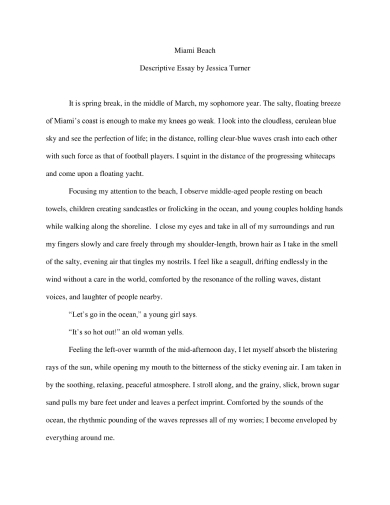
cheylin.com
Descriptive Essay Sentence Writing Example
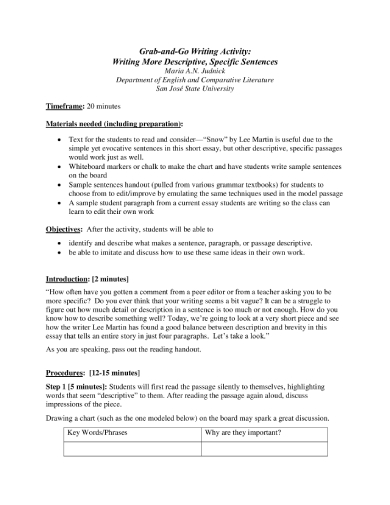
Descriptive Essay Paragraph Guidelines Example
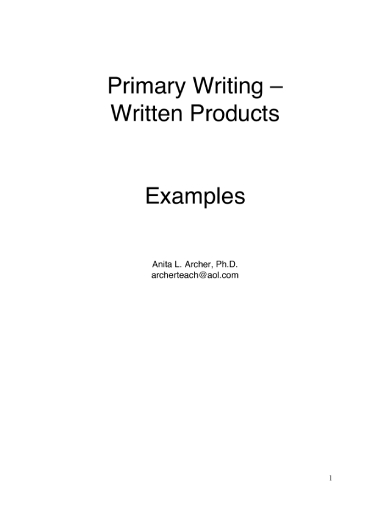
Stylish Descriptive Essay Rubric Example
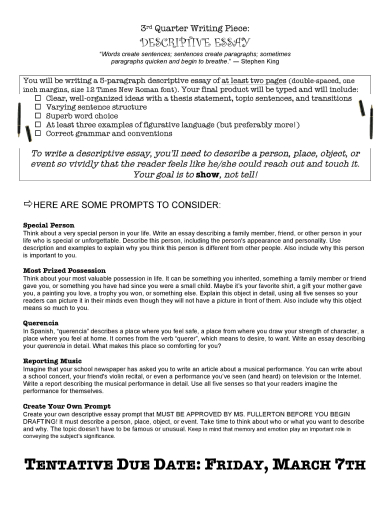
Descriptive Essay Writing Techniques Example
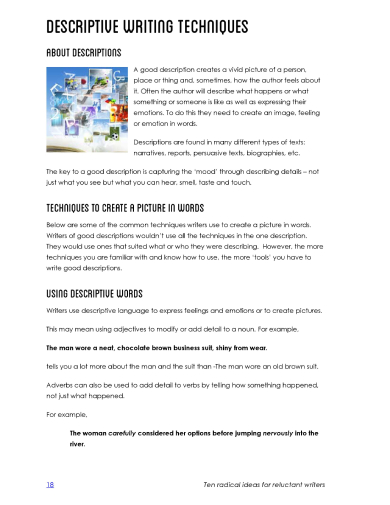
multifangled.com.au
Free Descriptive Essay Example
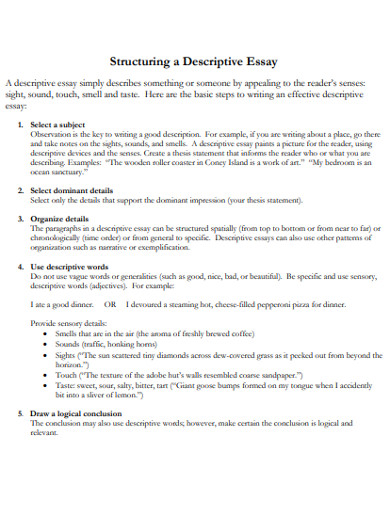
asc.weebly.com
Basic Descriptive Essay Example

hortonskids.org
Sample Descriptive Essay Example

essaytigers.com
Descriptive Essay in PDF Example
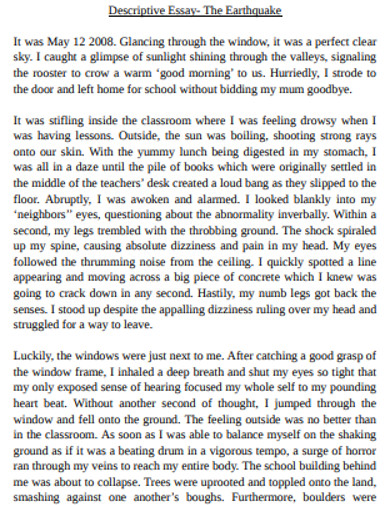
Printable Descriptive Essay Example
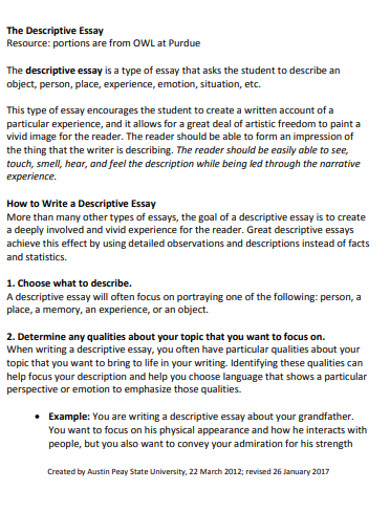
Direction Descriptive Essay Example
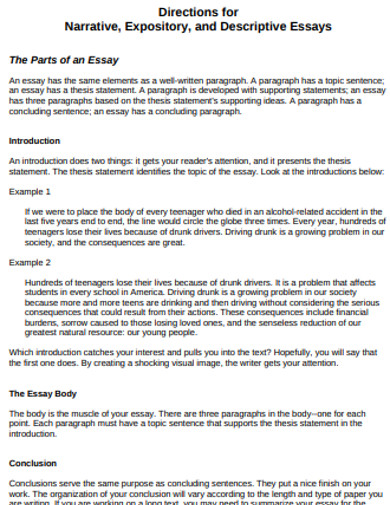
wba.aplusanywhere.com
Descriptive Essay Scoring Guide
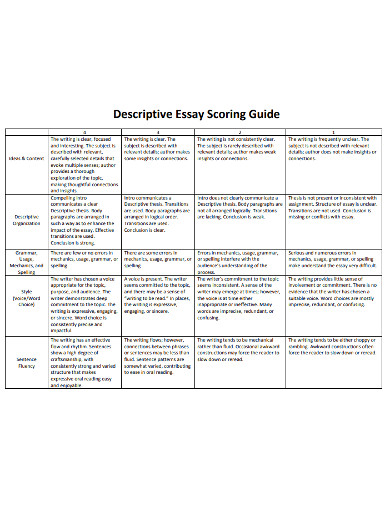
washoeschools.net
Professional Descriptive Essay

Descriptive Essay Format Example
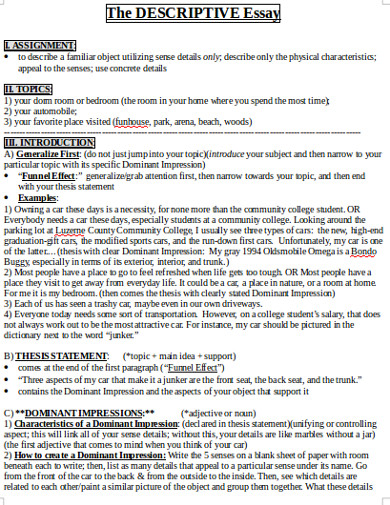
staff.kings.edu
Assignment Descriptive Essay Example

fd.valenciacollege.edu
What are the 4 types of essays?
An essay is an extended piece or composition that shows and supports a thesis or proposition. Essays help the expression of an author’s ideas in various ways. Before composing your own essay, it is important to identify its purpose first, and in doing that, distinguishing its type would be a great beginning. Correspondingly, here are the four different types of essays:
Narrative Essays: to tell
Taking it into its most basic sense, narrative essays are used if the author wants to tell a story about a real-life adventure. This type of essay is expressed in a particular point-of-view. Commonly, it is the author’s viewpoint that is being followed. Moreover, in writing your own short narrative essay , apply realistic emotions and appropriate sensory details to provide your readers with the full taste of your story. By doing this, you are not simply telling them but also engaging them in the story’s sequence and elements. It is also advisable to state verbs as vivid and as precise as possible. The thesis statement of a narrative essay is commonly found in the opening sentence or the last sentence of the introductory paragraph.
Descriptive Essays: to describe
You may confuse yourself between narrative and descriptive essays ; however, differentiating both is really easy. Rather than telling a story, a descriptive essay illustrates a specific topic such as a person, place, experience, emotion, event, etc. by means of words. You don’t simply state your experience in this type of essay; on top of that, you let your reader experience the same thing through your descriptions. In writing your own short descriptive essay , it is important to remember that you are not writing to tell but to show. Using sensory and vivid words is also recommended.
Expository Essays: to uncover and clarify
From its name itself, an expository essay is used to expose something on matters that are known to others. This type of essay is a genre of composition that aims to explain, illustrate, clarify or explicate a certain subject for the readers. Thus, an expository essay could include investigation and evaluation of ideas. This could be derived through comparison and contrast, definition, giving examples, assessment of cause and effect, etc. Moreover, in composing an expository essay, the author set his/her emotions aside for this type of essay is based on mere facts. The first point-of-view is not applied in this essay as well.
Persuasive Essays: to convince
If the expository essays talk about the facts then persuasive essays talk about arguments. The main purpose of a persuasive essay is to win over the trust of the reader to accept your viewpoint, opinion or proposition as the author. In writing a persuasive essay, your opinions should be supported by relevant facts and logical and sound reasoning. Though the essayist should lay all necessary details from both sides of the argument, he/she must comprehensibly explain why one side is correct or more favorable than the other.
Despite essays being categorized into four types, it is also important to know that an essay is not limited to one type only. In some cases, a narrative essay could also be mixed with a short descriptive essay or a short persuasive essay combined with an expository type. Nevertheless, identifying the purpose of your essay is vital before writing. However, if doing it challenges you, knowing these types is a great substitute.
What Is the Purpose of a Descriptive Essay?
Some people like to watch movies rather than to read books. This is because an actual image is easier to absorb than that on writing. This is why it’s important for a writer to pay close attention to detail. A descriptive essay conclusion should provide the reader with a mental picture of a given matter.
This is especially essential when writing pieces meant for a younger audience, as they have a more imaginative mind than the average adult. A writer must be creative when using imaginative language in order for the reader to properly comprehend what is being portrayed. To do so, the writer should also be knowledgeable about the topic. After all, you don’t want to give your readers the wrong interpretation .
How to Write a Descriptive Essay
A good descriptive essay comes from a knowledgeable and imaginative mind. Thus, in descriptive writing , it’s important for one to be specific on details. After seeing a few samples that we have shown earlier, here is a step-by-step guideline to help you in composing a descriptive essay worth reading.
1. Choose a topic.
If there is no given topic, it would be great to select one that you are knowledgeable and familiar with. Considering that your whole descriptive essay would revolve on this specific subject, choosing a topic that you recognize would keep everything simpler for you. By doing such, you can freely decide what words are the most appropriate to use; as a result, it will be easier for you to describe your topic. Furthermore, your reader could be meticulous and educated on your subject, so being knowledgeable about your own topic is wise prevention against bad impression.
2. Construct your thesis statement.
Alright, now that you have your own topic already, it is important to know what specific message you want your reader should focus on reading your whole essay. Thus, it is important to always provide a thesis statement , the umbrella sentence of all your ideas. Write this in one concise sentence in your introduction and conclusion. Often, a thesis statement is mentioned in the last sentence of your introductory paragraph.
3. Gather the necessary information and ideas.
Though you are already proficient in your topic, it is still recommendable to research about your specific subject. With this, you are not just gaining new information but also checking the correctness of your knowledge. It would also be great to expand your vocabulary, especially in adjectives and adverbs, since writing one of these involve loads of describing. Moreover, also focus on the sensory words that correspond to sight, smell, taste, sound, and touch of the given subject.
4. Create an outline.
Obtaining all of the significant details, crafting an essay outline for your work will allow you to arrange your contents in a rational and chronological order. Also, being educated with different formats in writing an essay would really make a great difference in your composition.
5. Proofread.
After writing your own descriptive essay, it might feel perfect already, but most of the time, it is not. Hence, read your entire work and review if there are any errors pertaining to your grammar and spelling. Furthermore, asking for help from a well-versed friend of yours to conduct a peer-review to your work would be extremely useful.
6. Finalize your composition.
The next thing to do after the editing is to finalize your descriptive essay to its finest version. Make sure that your essay follows a specific format, consisting of the proper parts of the essay .
Smart Tips for Writing a Descriptive Essay
The fundamentals of the descriptive writing procedures are now given to you; nevertheless, it would always be great to aim for something better. Now, here are some intelligent tips that would make your essay certainly more compelling.
Establish a connection with your writing.
The key to writing a good effective essay is to have the passion to write it; thus, in choosing your topic it would be great to have a familiar one or a subject that truly makes you curious. Let your interest be the seed of your fruitful composition.
Spend time to think.
In writing your own descriptive essay, let your brain do its job. Do not rush, give yourself an adequate amount of time to ponder on the necessary details that you should include and what approach you should apply. Provide yourself a clear plan of your descriptive essay writing. Moreover, look at your topic from different angles. This will allow you to take a closer look at every detail of your subject.
Apply the word vomit technique.
The word vomit technique or also called as “ free writing ” is the spontaneous use of words without considering any rules. This is a good technique in making a draft of your starting an essay . It allows your ideas to keep flowing without exerting much effort. Once this is done, you can pick out points that would go well with your essay.
Take a break before finalizing it.
Because right after writing your composition, your thought highly recognizes your word construction; thus, it does not really notice the errors and automatically treats them as correct pieces of your work. Allowing your mind to clear out for a while will make it easier for you to critic your own work. Furthermore, utilizing grammar-checking software is also a splendid move.
Text prompt
- Instructive
- Professional
Write a descriptive essay about a place you love to visit and what makes it special.
Describe in a descriptive essay your dream job and what it would be like to work there.
Published in
13 Best Descriptive Essay Examples and Templates
A Descriptive Essay is a genre of essay writing that allows a writer to provide a vivid description of something- a person, an event, a place, a personal experience, an object, an emotion, etc.
Descriptive essays, like narrative essays, tend to allow the writer a great deal of artistic freedom than most academic writings. Good descriptive essays examples include newspaper articles, research papers, travelogues, memoirs of a personal experience, book reports, among others.
Purpose of Descriptive Essays
The primary purpose of writing a descriptive essay is to provide enough detail about a given topic to enable the reader to visualize it. Descriptive essays test a writer’s ability to use language creatively and originally to give the reader a more robust understanding of the specific topic or subject of discussion. This form of writing does not involve convincing readers or showing information to prove a point, like in argumentative essays, but it aims at describing all the important details about the given topic to make the reader understand it more easily.
Descriptive writing also benefits the author of the work. Whether the subject of a writer’s essay is personal or of cultural importance, descriptive essays are fundamental to mastering the art of descriptive writing. Descriptive essays are mostly assigned to high school students in composition classes to teach them the basics of writing and self-expression.
Essay Examples
Following are some free downloadable templates for you:
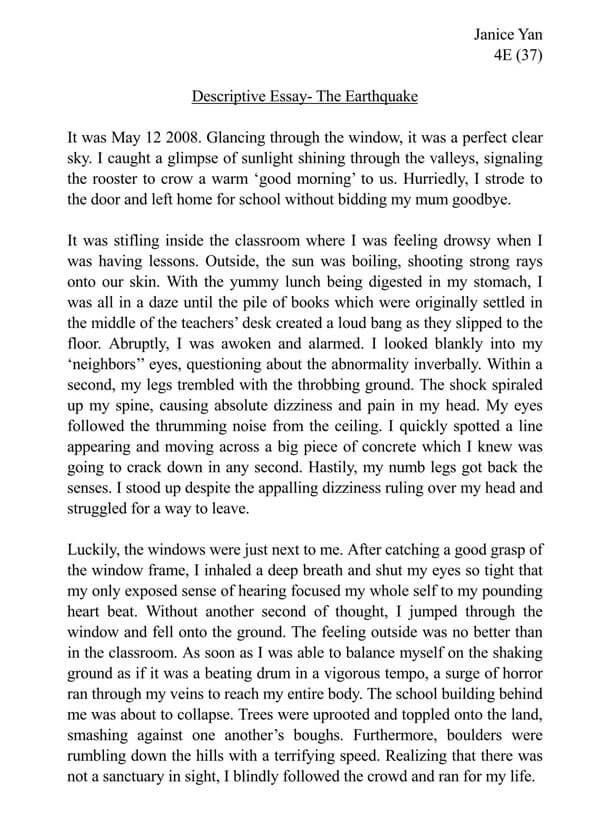
Descriptive Essay Writing Guidelines
The process of writing an effective descriptive essay involves topic selection, creating an outline, organizing ideas or points, and adding relevant information into the essay.
The following is a procedural guideline for descriptive essay writing:
Choose a particular prompt
Descriptive essay assignments tend to provide writers with a particular prompt or choice of prompts. Such assignments will often ask the writer to describe something based on personal experience, describe something out of imagination, or describe something more abstract, like an emotion. In either case, the writer should try to think of a topic that they feel they can comfortably describe in detail.
The selected essay topic should provoke specific feelings or sensations, and it should be a topic that the writer can describe in an appealing way to compel the reader to want to read more. When selecting an appropriate topic, it might be a great idea to summarize the essay’s main idea into a clear and defined thesis statement. The thesis statement should be less about the writer’s personal point of view and more about making a lasting impression on the reader’s mind.
Brainstorm/write down information
Next, the writer should take some time brainstorming ideas about their topic or prompt choice. Afterward, the writer should create a draft of their descriptive essay outline to organize information in a proper sequence. Writing down information on the given topic also helps writers structure their descriptive essay correctly and reminds them to include all the sensory details.
Write a descriptive essay introduction
An effective descriptive essay usually begins with an introduction. Here, the writer introduces the main topic of discussion and includes a strong opinion that creates the essay’s first impression. This is known as a hook , and it should be in the form of a rhetorical question or a bold statement. Next, the writer should provide a global context and highlight questions, points, or ideas that the rest of the essay will discuss. The thesis statement of the essay should be written as the last sentence of the introductory paragraph.
Writers should write a thesis statement that is clear and precise. The narrow subject line should also be written creatively and mysteriously to attract readers to the essay’s body.
Example of a hook and a thesis statement in descriptive essay writing:
My personal experience of fear For many reasons, the dark forest is my greatest fear, though not a fear that I necessarily like to venture into.
Body paragraphs
In most cases, descriptive essays encompass three body paragraphs. Each body paragraph covers a different point or argument, and it should begin with a topic sentence that anchors the reader’s attention and informs them what to expect from the paragraph. While writing a descriptive essay’s body paragraphs, writers are encouraged to be as specific as possible and avoid overwhelming readers with too much irrelevant information. Including 2-3 specific examples in the paragraphs also creates an impression on the readers’ minds.
Tip: It is essential to finish a body paragraph by introducing the next. To achieve this, appropriate transitional phrases are encouraged as they create immersion within the essay. This makes the essay better, and it will not come out as a list of facts.
Concluding paragraph
According to the descriptive essay’s format, the concluding paragraph should be a summary of all the points discussed in the essay’s body. However, the writer can also use it to reiterate the main point of the essay discussed in the introductory paragraph.
Tip: Writers should never introduce any new points in the essay’s conclusion. If there are any major points to discuss, it is best to create another body paragraph.
Proofread to upgrade the essay
After writing the essay, the writer should proofread the entire document to find out and correct any grammatical and spelling errors. Proofreading will also enable the writer to find areas where sensory details and descriptive language can help enhance a description. Including literary tools and figurative language in the essay creates a memorable image of the essay’s subject in the reader’s mind.
Tips to Improve Descriptive Writing
A writer’s ability to provide vivid descriptions on a given subject and make the subject’s settings and characters spring to life in the readers’ minds is critical in writing effective descriptive essays.
The consideration of the following key tips can be very beneficial to writers:
Brainstorm efficiently
This is a pre-writing consideration that writers should take into account to improve their descriptive writing skills. Taking a few minutes to brainstorm an essay’s topic helps writers generate ideas, develop order, and ease tension that often results in a loss of ideas or words amid writing.
Use of descriptive adjectives
Writing descriptively involves choosing the right words for an essay’s topic. The use of descriptive adjectives is important as they help add more information about the number, color, type, and other qualities of the nouns and pronouns used in the essay’s text. A writer’s choice of adverbs, verbs, and nouns is also crucial in providing readers with vivid descriptions, but their choice of words should remain relevant to what they intend to describe. While writing a descriptive essay, writers should avoid using cliché phrases and focus on more precise, original, and straightforward phrases. Using a thesaurus can help writers to find alternative word choices, but they should be careful not to overuse it.
For example:
As we walked through the thick forest, I looked back and saw an angry, green, venomous snake crawling from beneath the thick shrubs.
Vivid language
Good descriptive essay examples often make use of vivid language. By describing something vividly, it means that the writer has used descriptive language to paint a clear picture of the subject matter on the reader’s mind, allowing them to see clearly what the author had envisioned. If possible, writers should describe emotions or feelings related to the topic to connect with their readers on a deeper level.
Sensory details
The use of sensory details in descriptive essay writing is another essential tip that writers should consider when writing their essays. This means not only referring to what something looks like but also exploring its sense of smell, sound, taste, touch, etc. With more abstract subjects like emotions, writers can include sensory details metaphorically. Writings that incorporate vivid sensory details are more likely to engage and affect the reader’s perception of the given subject. Nevertheless, it is imperative to note that not all sensory details will apply to every subject.
Love is like a crescent moon. It is both sharp and curved and firm and gentle. Its white glow is soft enough to ignore if you choose it but bright enough to make even broken glass glisten and shimmer like a treasure all its own.
Use of figurative language
Figurative language consists of devices like metaphors , personification, hyperbole, symbolism, and similes that use words in non-literal ways to paint a memorable picture in a reader’s mind. This is important as it gives an author’s work its creative edge making it unique and appealing to the readers. However, this does not imply that writers should fill their essays with figurative language, making the essay lose its meaning. Instead, writers should use these devices creatively at various points throughout the essay to make the essay interesting, reader-engaging, and convey a unique perspective of the subject.
When I saw the dove soar high above my home, I immediately knew that the worst was over (symbolism) After the death of my father, I spent several weeks drowned in a sea of grief (Metaphor) The ocean’s water is as clear as crystal (simile) The night was calm. The only sound that could be heard was that of the howling winds (personification) The Corona Virus Pandemic and lockdown era showed us tougher times. A normal 24 hours day seemed like a month, and months seemed to be years (hyperbole)
Organize well
Good descriptive writing should be organized. Some common ways to organize descriptive writing include the chronological order (time), spatial (location), and order of importance. Providing organized and logical descriptions of events, people, objects, situations, etc., makes it easier for the readers to follow and understand the main ideas presented in the essay.
Get Help from Descriptive Essay Examples
Descriptive essays are a writer’s tool to communicate an experience they have had or illustrate a subject they have expertise in. Whether one plans to write a personal, subjective account or provide a more rigorous description of a particular subject, the following various descriptive essay examples will guide writers to effective descriptive essay writing. Our descriptive essay examples are originally written using the common 5 paragraph method, and they incorporate all the essential tips to effective descriptive writing. Review these descriptive essay examples to help you get started today!
Final Words
A descriptive essay is a genre of writing that prompts students to provide a vivid description of something. When writing descriptive essays, writers are encouraged to describe the given subject in a manner that makes the reader envision what they are describing. To achieve this, writers should make use of figurative language, sensory details, descriptive adjectives, and strong word choices to create memorable descriptions. Additionally, writers are encouraged to read various descriptive essay examples from reputable sources to improve their overall descriptive essay writing skills.
Keep reading
After school routine (schedule) templates, 15 best printable coloring pages for kids – pdfs, 10 free dissertation & thesis templates, 14 best research paper outline examples, 13 best narrative essay examples & templates, 9+ free classroom printable shapes | print and cut shapes.
Sheet Templates , Education
Pardon Our Interruption
As you were browsing something about your browser made us think you were a bot. There are a few reasons this might happen:
- You've disabled JavaScript in your web browser.
- You're a power user moving through this website with super-human speed.
- You've disabled cookies in your web browser.
- A third-party browser plugin, such as Ghostery or NoScript, is preventing JavaScript from running. Additional information is available in this support article .
To regain access, please make sure that cookies and JavaScript are enabled before reloading the page.
- International
- Education Jobs
- Schools directory
- Resources Education Jobs Schools directory News Search

KS2 Descriptive Writing - Thunderstorm! PDF
Subject: English
Age range: 7-11
Resource type: Worksheet/Activity
Last updated
24 August 2024
- Share through email
- Share through twitter
- Share through linkedin
- Share through facebook
- Share through pinterest

Great descriptive/creative writing example paragraph - describing a thunderstorm.
Can be used to introduce a descriptive writing activity for pupils.
Also included are notes re: which features to include to make writing more expressive.
Key features include: examples of creative language choices/vocabulary in order to create mood/atmosphere/setting.
Illustrates expaned noun phrases/adverbials/varied sentence structures.
Suitable for KS2.
Further descriptive paragraphs can be found at following:
Erupting Volcano: https://www.tes.com/teaching-resource/resource-12960494 (word doc)
https://www.tes.com/teaching-resource/resource-12984370 (powerpoint)
Abandoned House in Forest:
https://www.tes.com/teaching-resource/resource-12960501 (word doc) https://www.tes.com/teaching-resource/resource-12978017 (powerpoint)
Dragon hunting: KS2 Descriptive Writing Paragraph Model – Dragon! https://www.tes.com/teaching-resource/resource-12959414
Same dragon paragraph as a Powerpoint: https://www.tes.com/teaching-resource/resource-12959437
Also, a resource with ideas of how to make descriptive/creative writing more exciting using figurative language: https://www.tes.com/teaching-resource/resource-12986538
Tes paid licence How can I reuse this?
Your rating is required to reflect your happiness.
It's good to leave some feedback.
Something went wrong, please try again later.
This resource hasn't been reviewed yet
To ensure quality for our reviews, only customers who have purchased this resource can review it
Report this resource to let us know if it violates our terms and conditions. Our customer service team will review your report and will be in touch.
Not quite what you were looking for? Search by keyword to find the right resource:

IMAGES
VIDEO
COMMENTS
Describing the senses is a powerful tool in writing a descriptive essay about a place. By skillfully using language to convey the sights, sounds, smells, and other sensory details, you can transport your reader to the place you are describing and create a lasting impression. Concluding with Impact: Emotions and Reflections
A descriptive essay is a type of writing that aims to describe and portray an object, person, or place. The essay typically includes sensory details to help the reader imagine its contents more vividly. Descriptive essays can be written about a person, place, or other themes like nature, autumn, food, or even yourself.
This format has 5 paragraphs in total. The sequence of the paragraphs is as follows; Introduction. Body Paragraph 1. Body Paragraph 2. Body Paragraph 3. Conclusion. Following is an example of a descriptive essay written using the famous 5 paragraph method. 5 Paragraph Descriptive Essay.
An example of a short descriptive essay, written in response to the prompt "Describe a place you love to spend time in," is shown below. Hover over different parts of the text to see how a descriptive essay works. Descriptive essay example. On Sunday afternoons I like to spend my time in the garden behind my house.
Step 4. Write the introduction. An introductory paragraph in a descriptive essay offers you a lot of flexibility in how you choose to write it. You can start off with a particular example of a sense perception, drop your reader in the middle of a town square, or begin with an abstract concept.
Descriptive essays breathe life into words by painting a vivid picture of a person, place, thing, or experience. They employ sensory details and expressive language to make the subject come alive for the reader. Here's a basic yet effective structure you might use when crafting a descriptive essay: 1. Introduction.
A descriptive essay is essentially a short piece of writing in which the author describes a person or place using words that engage all five senses: sight, touch, smell, sound and taste. As the author, you will be required to convey the physical and, more importantly, the emotional attributes of the person or the place you are describing.
A descriptive essay is one of the four main types of essays, alongside narrative, argumentative, and expository essays. Among these, descriptive essays can be particularly challenging because they demand a keen eye for detail and an appreciation for aesthetics. By vividly describing scenes and details, you engage your reader's senses, making ...
Best Tips for Writing a Descriptive Essay. Outline the essay in sections and create a thesis statement to base the essay on. Then, write a strong introduction and describe the subject matter using creative and vivid adjectives. Use similes, metaphors, and your own emotions to help you bring the topic to life. Part 1.
When writing a descriptive essay about a person or place, adding their personal traits will be helpful. Some examples of descriptive essay topics include: Compose a detailed descriptive essay about your best friend. Describe a fancy place that you have created. Describe your dream vacation destination.
Outline example. Introduction. Hook sentence with detailed descriptions that grabs the reader's attention. Brief background about the place. Sensory descriptions of the place. Body paragraph. Section 1. Topic sentence that supports the thesis statement. Describe the place by the name and the exact location.
Imaginative descriptive essays also allow you to describe different emotions. Example, the feelings a parent experiences on holding their child for the first time. Characteristics of descriptive essays. The aim of a descriptive essay is to provide a detailed and vivid description of a person, place, object, event, or experience.
1) Be specific. The more specific you are, the more readers will be able to relate to your descriptions. For example, "The heat outside made me feel sluggish and exhausted" is a more effective description than, "It was so hot outside.". 2) Write first, edit later. Break writer's block by writing unedited.
Developing a clear and organized outline is an essential step in the process of crafting a well-written descriptive essay. By creating an outline, you can effectively structure your thoughts and ensure that your essay follows a logical progression. It serves as a roadmap for your writing, allowing you to focus on the main ideas and supporting ...
Following are the steps involved in the pre-writing or planning procedure of a good descriptive essay: 1. Topic Selection. Usually, professors assign the topic for a descriptive essay. But, if you have a choice to select a topic, then you have a great chance to select something which you know a lot about.
Descriptive Essay Example about Emotions. Describing emotions and feelings is difficult. Memories, emotions, and feelings are abstract and, therefore, explaining them is not easy. They cannot be explained independently, as you can explain a place or event. A descriptive essay about emotions includes an event and the feelings associated with it.
The use of literary devices such as personification and metaphor makes the banyan tree in the second example come to life. This is how you can make your writing more vivid, descriptive, and poetic. 2. Use your senses. Sensory descriptors are one of the most important aspects of a descriptive essay.
A Descriptive Essay is a category that describes something such as a place, object, experience, situation or emotion, etc, in a detailed and vivid manner.. It requires the writer to use his/her creative writing ability to paint a picture in the reader's mind by providing a comprehensive account of the experience.
Descriptive Essay on My Favourite Place. Imagine a place where the sun always shines, the air is filled with the sweet scent of blooming flowers, and the sound of gentle waves lapping against the shore lulls you into a state of peaceful bliss. This is my favorite place, a sanctuary from the chaos of everyday life, where I can escape and recharge.
A descriptive essay is a type of writing that aims to vividly describe a person, place, object, or event. In this type of essay, the writer uses sensory details such as sight, sound, smell, taste, and touch to create a clear and vivid image in the reader's mind. The goal of a descriptive essay is to evoke a strong emotional response or create ...
A descriptive essay is a type of essay that involves describing a person, object, or any type of noun. ... we can give you a descriptive essay example to guide your way. Image Credits. DESCRIPTION descriptive essay full example with labels ... but for me, that is part of its charm. It is a place of warmth and love if you look close enough, and ...
A Descriptive Essay is a genre of essay writing that allows a writer to provide a vivid description of something- a person, an event, a place, a personal experience, an object, an emotion, etc. . Descriptive essays, like narrative essays, tend to allow the writer a great deal of artistic freedom than most academic writings. Good descriptive essays examples include newspaper articles, research ...
So, I climb high to the mountains and slow peaks, leaving behind the calm and peace of sunny forests and meadows. This place is both spectacular and dangerous at the same time. It has steep cliffs and sheer drops, so I should be focused and attentive. When I reach the snow peak, there is nothing except the blue sky, blinding sunlight, and snow.
An Example of Descriptive Essay Descriptive Essay 1) Definition: Descriptive essay is one of the many types of writing styles that provides a detailed description for a particular person, place, memory, experience or object. Descriptive essay is purposely created so readers can readily
This digital file contains a carefully crafted sample answer to the GCSE English Language question: "Describe a place where you have felt comfortable. ... By providing a high-quality example of descriptive writing, it helps students see how to effectively apply language techniques to answer questions. The clear, engaging style makes it easier ...
Great descriptive/creative writing example paragraph - describing a thunderstorm. Can be used to introduce a descriptive writing activity for pupils. Also included are notes re: which features to include to make writing more expressive. Key features include: examples of creative language choices/vocabulary in order to create mood/atmosphere ...